A Sit Down With Our Leadership
An Interview with the Deputy for the Orient Konohia and State Grand Loyal Lady Ruler Walker

An Interview with the Deputy for the Orient Konohia and State Grand Loyal Lady Ruler Walker
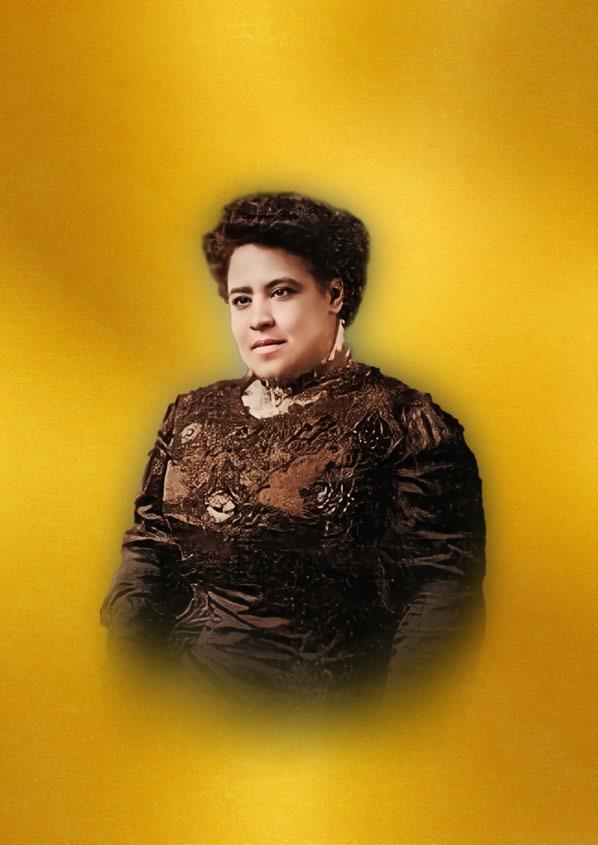
Originator Of The Order Of The Golden Circle
Reflections
From the Louis W. Roy Sr. Council of Deliberation 2023 Annual Session
Light Seekers...
Are We?
The Power Couple of the Literary and Masonic World
Robert Lewis Pendleton and Leila Amos Pendleton
Timeline To History
Before the Big Bang
Capping Ceremony
SGIG Bert A.G. Overby 2023 Class
John 15:13
Transforming Death
you to the latest issue of the are honored to have the you many insights, stories, highlight the beauty of the OriColumbia.
a wealth of thought-proexplore the history and inspiring the positive impact that has on the world around us, of Robert Lewis Pendleton Pendleton, the power couple of the world. We take you on a jourand how their contributions well as, the role they played Golden Circle.
an interview with the leaderSr. Council of Deliberation, Konohia and the Matthew Assembly, State Grand Loyal Lady Ph.D., the Capping Ceremony
Overby 2023 class and Louis Deliberation 2023 Annual Sesmade when the gavel was the Temple by a Prince Hall history.
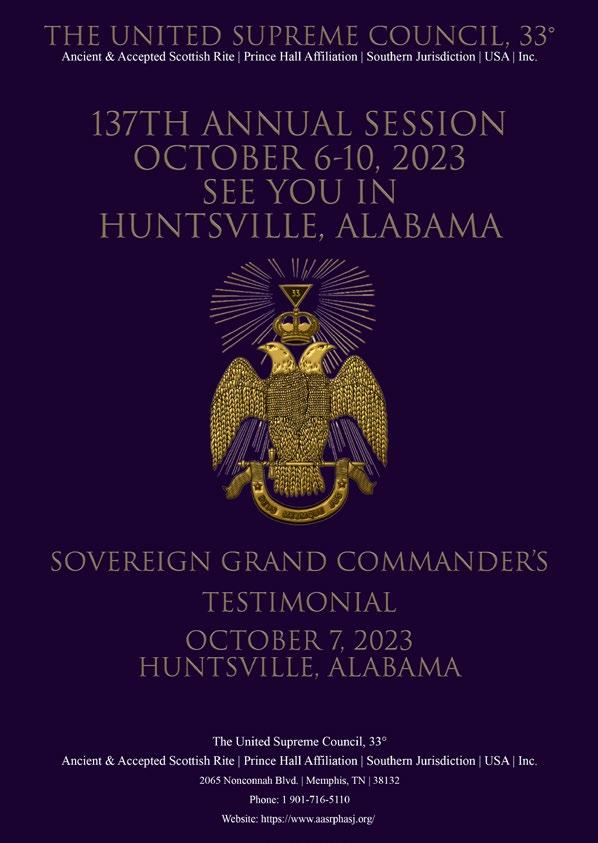
Dear readers,
I am thrilled to welcome you to the latest issue of the Chokmah Newsletter. We are honored to have the opportunity to share with you many insights, stories, and experiences that highlight the beauty of the Orient of the District Of Columbia.
In this issue, you will find a wealth of thought-provoking articles that explore the history and inspiring stories that demonstrate the positive impact that our Masonic community has on the world around us, beginning with the story of Robert Lewis Pendleton and Leila Amos Pendleton, the power couple of the literary and Masonic world. We take you on a journey of each of their lives and how their contributions influenced the world, as well as, the role they played in The Order Of the Golden Circle.
This issue also includes an interview with the leadership of the Louis W. Roy Sr. Council of Deliberation, the Illustrious Deputy Eric Konohia and the Matthew Ellis Jr. State Grand Assembly, State Grand Loyal Lady Ruler Shelly L. Walker, Ph.D., the Capping Ceremony for the SGIG Bert A. G. Overby 2023 class and Louis W. Roy Sr. Council of Deliberation 2023 Annual Session where history was made when the gavel was sounded in the House of the Temple by a Prince Hall Mason for the first time in history.
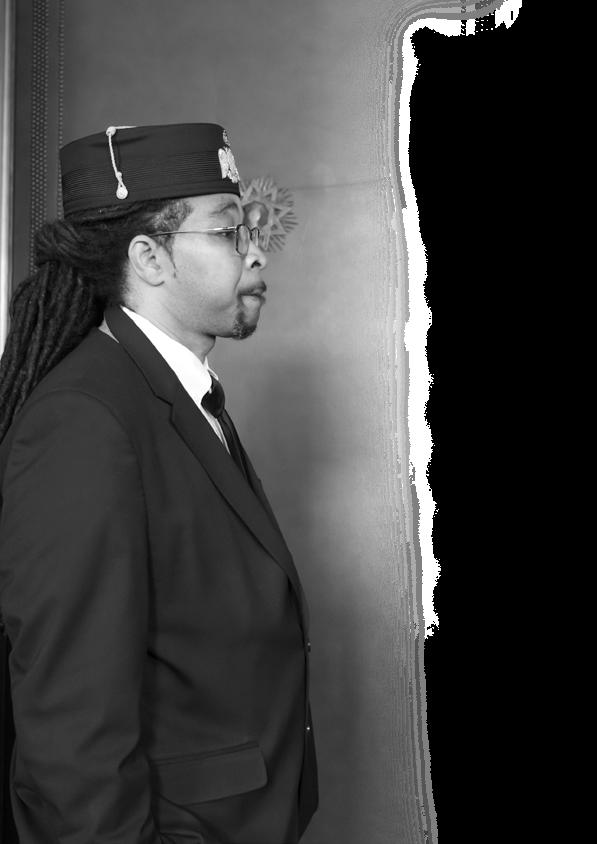
Our contributors have worked hard to bring you content that is informative, engaging, and meaningful. We hope that their words will inspire you to deepen your understanding of Masonic principles and to continue your journey toward personal growth and enlightenment.
As always, we are grateful for your ongoing support and participation in our Masonic community. We encourage you to share your feedback and ideas with us, so that we may continue to serve you and the wider Masonic family in the best possible way. Thank you for your commitment to the Chokmah Newsletter, and we look forward to sharing this issue with you.
Fraternally,
Matthew Williams SP Matthew Williams Editor-In-Chief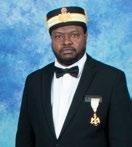
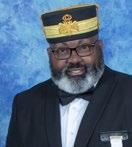

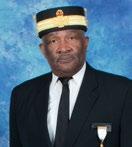
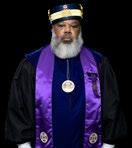
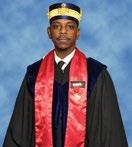
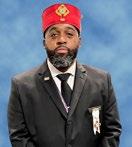

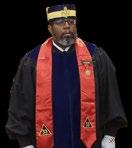
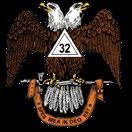



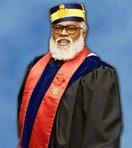
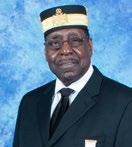
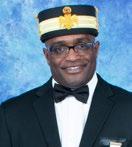
The Official Publication of Valley Of Washington
Orient Of The District Of Columbia
Louis W. Roy, Sr. Council Of Deliberation
The Talmud (Shabbat 31a) describes knowledge of the Talmudic order of Kodshim as a high level of wisdom, chokmah. In the Kabbalah, Chokmah is the uppermost of the sephirot of the right line (kav yamin, the “Pillar of Mercy”) in the Tree of Life. It is to the bottom right of Keter, with Binah across from it. Under it are the sephirot of Chesed and Netzach. It commonly has four paths going to Keter, Binah, Tifereth, and Chesed (Some kabbalists such as Rabbi Isaac Luria also attributed a path between Chokmah and Gevurah).
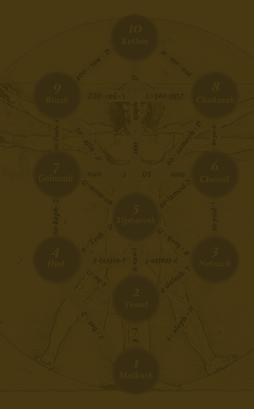
This issue of the CHOKMAH Newsletter is erected on the direction of:
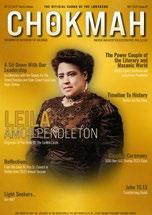
EDITOR-IN-CHIEF: SP Matthew Williams, 32°

GRAPHIC DESIGNER: SP Matthew Williams, 32°
STAFF PHOTOGRAPHER: SP Tony Mobley, 32°
SP Victor Sherrod, 32°
COPY EDITORS & CONTRIBUTING WRITERS:
SGIG Eric Konohia, 33º
SGIG Marcus D. James, Sr., 33º


KCCH Dr. Paul Cotton, 32°
KCCH Tryone S. Hurley, Jr. 32°
SP Albert Murray, 32°
SGIG Glenn N. Ruffin, 33º GIG Guy Borden, 33º
SP Dgessay Major, 32°
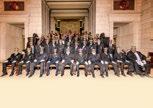
LL Catrice Vandross
CHOKMAH Newsletter is published bi-monthly. Deadline for copy is the 1st of the month, preceding month of issue.
ALL MATTERS FOR PUBLICATION IN THIS NEWSLETTER SHOULD BE ADDRESSED TO:
CHOKMAH Newsletter, Louis W. Roy, Sr. Council of Deliberation
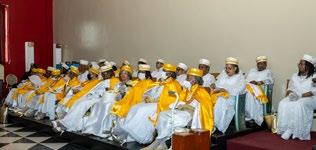
1000 U. St, NW Washington, DC 20001; Email: chockmah@lwrsrcod.org;
SUBMISSIONS:
Submitted articles should be between 500 to 1,500 words. High resolution images are required, when available, with proper permission and credit.
Published articles do not necessarily reflect the policies or opinions of the Louis W. Roy, Sr. Council of Deliberation.
CHOKMAH Newsletter is designed and produced by the Sublime Princes of the Orient of the District of Columbia.
Distributed to all fraters within the Valley of Washington, Orient of the District of Columbia and A∴A∴S∴R∴ PHA∴SJ-USA

Electronic versions of the CHOKMAH Newsletter can be viewed or downloaded at https://lwrsrcod.org and https://issuu.com.
54
59
65
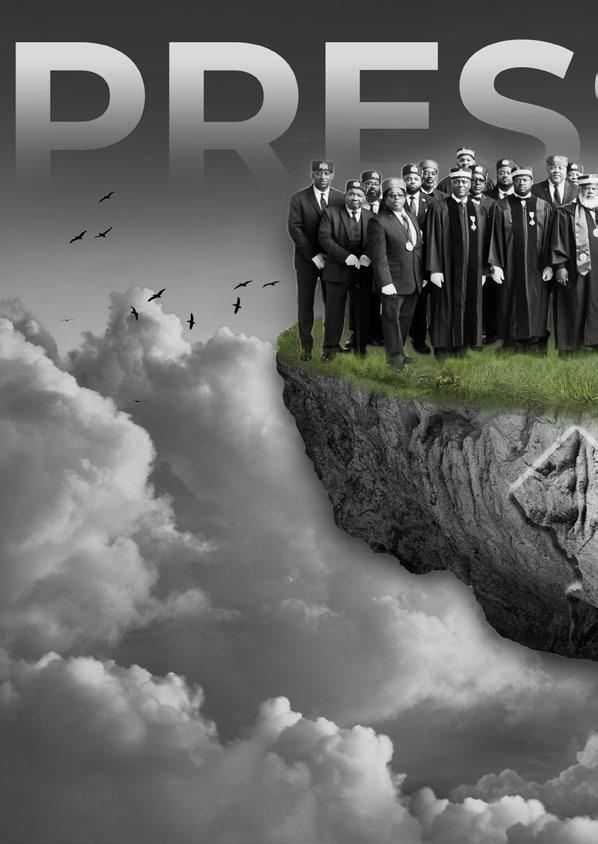
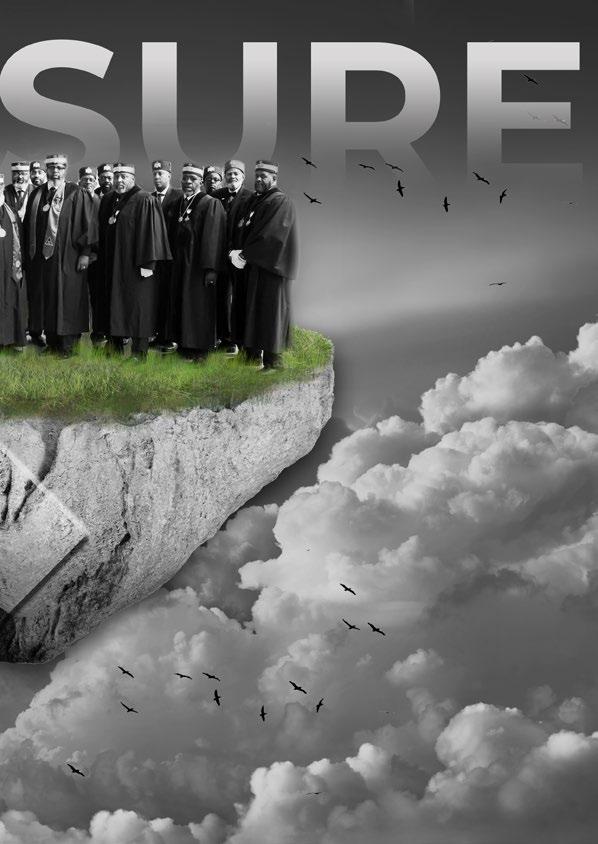
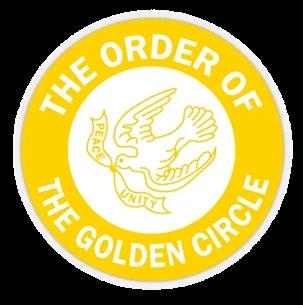
Early in the year of 1907, certain gentlemen of the Ancient Accepted Order of the Scottish Rite of Freemasonry for the Southern Jurisdiction of the United States of America conceived the idea of forming a Ladies Auxiliary to the Jonathan Davis Consistory of Washington, D.C.
They felt that as in other branches of Masonry, their wives, mothers, sisters and daughters could be of great assistance to them and furthermore could partake of such courtesies as the Sublime Princes could offer to blood relatives. To Ill. Andrew Laster, 33°, whose untiring zeal was known to these brethren, was given the task of organizing the Auxiliary. Furnished with the names of certain ladies prominent in Eastern Star Chapters, he proceeded to organize the Auxiliary, hereafter to be known as the Ladies’ Auxiliary to Johnathan Davis Consistory. The growth at first was disgustingly slow, but later, Mr. Laster, who was made of stuff that pioneers were made of, refused to be discouraged. He visited the ladies in every area that he could approach them and urged them to attend the meetings and sought out new members. At many times only two, and sometimes one, attended the meetings. But he never lost courage. In October, 1907, the Auxiliary received a new impetus, new members were added, the old ones took on new zeal and the Auxiliary started on its present course of success.
About this time, the new Sovereign Grand Commander, Robert L. Pendleton, 33°, who was then the Ill. Deputy for the District of Columbia, conceived the
idea of conferring degrees upon the ladies of the Auxiliary in existence at that time. Thus bringing them into closer relationship with the brethren of the Scottish Rite. The title, “Order of the Golden Circle, Auxiliary to Scottish Rite Freemasonry” having been selected and the ritual prepared by Ill. Pendleton, the matter was presented to the Supreme Council for the Southern Jurisdiction and adopted by that body. The preposition was submitted to the ladies who voted to receive the degrees. All the ladies who at that time were members of the Auxiliary were to be eligible, but thereafter, the membership was to be limited to those only possessing the Scottish Rite relationship.
On May 6, 1908, Ill. Pendleton assisted by other Ill. Sirs conferred the degrees upon the ladies. The obligations, signs and mottos were given. The ladies named their Assembly, “The Richard Howell Gleaves, Assembly No. 2, Order of the Golden Circle.” Number 1 was assigned to Queen Esther Assembly of Baltimore, Maryland, because the Scottish Rite Auxiliary of that city was the first to be organized in the Jurisdiction. This Assembly was named after the late Richard Howell Gleaves, one of the most prominent Masons in the United States at that time. Born in the earlier part of the nineteenth century, in that grand old Commonwealth of Pennsylvania, in his early manhood he went to the State of South Carolina. During the stirring days of reconstruction, he played a prominent part, at one time being the Lieutenant Governor of the state. He was a typical gentleman,
courtly and of the old world type of courtesy. He was the fifth Grand Master of the Prince Hall Grand Lodge of Ohio, serving from 1857 to 1861. He played a prominent part in the history of Black Masonry, and the very prosperous condition of Black Masons of the District of Columbia today is largely due to his tireless efforts. The ladies felt that no better nor fitting memorial could be given him than to have his name on their banner under the motto “Peace and Unity.”
The ritual, form of application, the Constitution and the burial service were all written by Ill. Pendleton and copyrighted under the laws of the United States in 1908.
The late J. Francis Rickards 33°, when he was Sovereign Grand Commander of the Northern Jurisdiction, decided to establish the Order of the Golden Circle in this Jurisdiction. Since the ritual was copyrighted, it was necessary for him to get the permission of Ill. Pendleton, which he did. Within a short time after obtaining this permission, Ill. Rickards established a number of Assemblies in this Jurisdiction. Yielding to the wishes of some of the ambitious ladies who were leaders of the Golden Circle, Ill. Rickards permitted the formation of a so-called Grand Assembly which operated on a national scale for several years. When Ill. Pendleton heard about this grand body he violently disapproved of the same.
In 1920 Ill. Rickards conferred with Ill. Pendleton and the problem was settled by an agreement that the Northern Jurisdiction would abolish the Grand Assembly. This was done and since that time until 1969 the Order of the Golden Circle existed in the Northern Jurisdiction on the same basis as it exists in the Southern Jurisdiction, where it originated.
In 1969 the late Ill. Leland D. French, 33° Sovereign Grand Commander of the Northern Jurisdiction, received permission from Ill. John G. Lewis, 33 ° Sovereign Grand Commander of the Southern Jurisdiction, to organize the State Grand Assemblies in the Northern Jurisdiction.
In compliance with Article VII, enacted at the 1970 Supreme Council, held at Detroit, Michigan, Ill. French met with Ill. John G. Lewis and the necessary changes were made in the Constitution and By-Laws.
RICHARD HOWELL GLEAVES NO. 2
Meeting: 3rd Tuesday Monthly
Loyal Lady Ruler
Annette Scarboro
JAMES W. BANYARD NO. 11
Meeting: 2nd Wednesday
January, April, June, September, December
Loyal Lady Ruler
PLLR Ruth Weston
HENRY A. DOVE NO. 15
Meeting: 1st Friday
January, April, June, October, December
Loyal Lady Ruler
Robin Belton
EDWARD E. MARSHALL NO. 18
Meeting: 3rd Wednesday
January, April, October, December
Loyal Lady Ruler
Diana Fasion
Shelly L. Walker, Ph.D
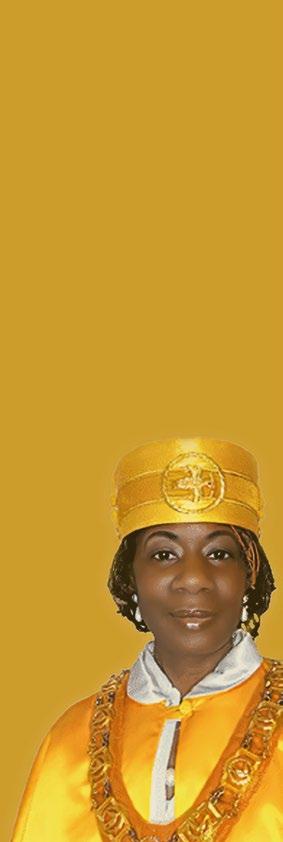

Robert Lewis Pendleton was born in Marianna, Jackson County, Florida, on July 16, 1865, to Robert Lewis and Hastie (Armstead) Pendleton. Working parents of a family of eight, his father was a shoemaker, and his mother a laundress. Their family included five sons Robert, Howard, Armstead, Lewis, and Love, and two daughters, Catherine “Kate” and Rosa.
Pendleton was a pioneer printer in Washington, DC. He began his printing career at the age of sixteen while living in Florida. As the years progressed, he joined the thousands, that would migrate
North, in search of new opportunities and prosperity. In New York, Pendleton became the publisher of the New York Globe. He moved to Washington, DC in search of what was called a “GGJ,” a good government job. In DC, he found a growing Black cultural scene with Howard University as an educational magnet.
While segregation still existed in Washington, it was more tolerable than it was in the South. Eight months before the Emancipation Proclamation was signed on January 1, 1863, over 3,000 enslaved persons were emancipated in DC This gave DC the distinction of
being the only part of the United States to have compensated slave owners for freeing the enslaved people they held in bondage. The compensation to every slaveholder, who was loyal to the Union was $300 per slave. Congress made payments totaling $900,000. Emancipation in DC allowed the nation to rededicate itself to the founding principles and become a vanguard of freedom, equality, and justice.
Throughout Reconstruction, segregation continued to exist in DC, while more tolerable than in the South. There were no signs that said, “colored only” or “whites only.” African Americans knew what the rules were, they knew the boundary lines, and they knew their “place.” Thus, DC became a haven for African Americans seeking the promises of the Emancipation Proclamation and the Thirteenth Amendment.
It is not a surprise that Pendleton made his home in DC, where he would become a pioneer in the printing industry. His craft as a printer was invaluable during that time in the District. First, he became a printer at the People’s Advocate, then became one of the first African American printers to establish a printing company in DC. His firm R. L. Pendleton Company and Pendleton’s Quality Printing House were located at 10th and F Street, NW, Washington, DC in 1886. For many years Pendleton taught printing at Howard University and was Howard’s main printer. Pendleton was a printer for the Most Worshipful Prince Hall Grand Lodge of DC. He later established the American Negro Monograph Company with John Wesley Cromwell, the former publisher of the People’s Advocate, who served as the editor. Their mission was to republish important, out-of-print African American essays. A few of the titles included The Confession Trial and Execution of Nat Turner, the Negro Insurgent (1910); Contemporary Evolution of the Negro Race (1910); Biography of Benjamin Banneker (1910); and The Social Evolution of the Black South by W.E.B. Du Bois (1911). The list of his publications is too
numerous to include. He was one of the most successful news and job printers in the country. Pendleton’s Printing company would eventually move to 1216 U Street, in NW, Washington, DC. A labor of love during his career was printing his wife’s books.
His wife, Leila Amos was born in Washington, DC in 1860, the only daughter of Joseph Ferdinand a 30-year police officer, and Maria Louise (Bruce) Amos a dressmaker. Amos had five brothers, James E., Ralph W., Ferdinand F., Ernest R., and Claude B. Amos.
Leila Amos was educated in the Washington, DC, Public School system, where she graduated from the M. Street School in 1886 and attended Myrtilla Miner Normal School in 1887. She wrote her class song and led her class in English compositions. She later became an educator in the same DC Public School system, teaching English for six years from September 1887 until 1893.
Amos and Pendleton were united in holy matrimony on November 15, 1893. In the District of Columbia. married women could not teach in DC Public Schools, so, she resigned from the public school system after her marriage.
Pendleton was described as an energetic versatile and kind woman who was prominent in civic, charitable, cultural, religious, and fraternal activities for more than fifty years.
She was an active member of St. Luke’s Episcopal Church in DC.
Robert and Leila Amos Pendleton were active members of the Prince Hall Masonic family. Robert Pendleton served as Worshipful Master of Pythagoras Lodge No. 9, Free and Accepted Mason in 1897, and Worthy Patron of Prince Hall Chapter No. 5 O.E.S. PHA in 1901. He was a Past Deputy Grand Master of the Most Worshipful Prince Hall Grand Lodge of the District of Columbia, and Sovereign Grand Commander, United Supreme Council, 33° Ancient & Accepted Scottish Rite of Freemasonry, PHA Southern Jurisdiction, USA, Inc. When the United Supreme Council was not allowed to join or use the White Temple in Washington, DC due to segregation. Pendleton
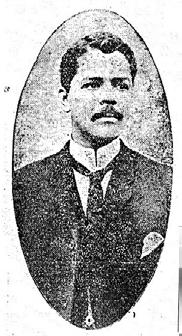
organized African American members to build their own Temple 10 blocks away. The ritual, form of application, the Constitution, and the burial service for the Order of the Golden Circle were all written by Pendleton and copyrighted under the laws of the U.S. in 1908.
Leila Amos Pendleton served as Worthy Matron of Prince Hall Chapter No. 5 O.E.S. – PHA in 1903. She was a member of the Heroines of Jericho, she was the fourth Loyal Lady Ruler of Richard Howell Gleaves Assembly No. 4, and served for many years as the National Secretary of the Assemblies of the Order of the Golden Circle.
The Pendleton’s were among those present to witness the historic inception of the Georgiana Thomas Grand Chapter of the District of Columbia, OES - PHA.
Throughout her life, she was a member of organizations that aimed to help women fight for their rights against racism and sexism in society. She was the
Photo Credit: Special Collections, Firestone Library, Princeton University | https://graphicarts.princeton.eduVice President of the Northeastern Federation of Women’s Club and for years a prominent member of the National Association of Colored Women’s Clubs. She was one of the leaders responsible for the restoration and renovation of the Frederick Douglass home, located in Anacostia in Washington, DC.
In 1907, Leila Amos Pendleton was also the founder and president of the Social Purity League of Washington. The Social Purity League was rooted in the Christian morality movement which aimed to preserve feminine virtue and purity by protecting young women and girls from prostitution, contraception, abortions, and male sexual predators. The League merged in 1918 with the Patriotic League of the National Young Women’s Christian Association (YWCA). The YWCA was the forerunner in the Social Movement with a mission to eliminate racism, empower women, stand up for social justice, help families, and strengthen communities.
The Black Women’s Club Movement emerged in the late nineteenth century and included several local reform organizations dedicated to racial advancement. Black women formed social organizations to provide services, financial assistance, and moral guidance to the poor. These grassroots organizations were primarily comprised of middle-class women who were part of the larger progressive reform effort. Many of the groups grew out of religious and literary societies and were organized in response to the intensified racism in the late nineteenth century.
Although the clubs existed all over the country, they were concentrated primarily in the Northeast. Women involved in the club movement developed organizing skills and gained knowledge about education, health care, and poverty. These clubs also sought to teach the poor how to keep a household, manage a budget and raise their children. The local groups were usually narrow in focus and supported homes for the aged, orphanages, and schools. In Washington, DC, the Black Women’s Club movement was dominat-
ed by teachers who were concerned about children and their problems. Active participants held conventions, conferences, and forums to engage the intellectual elite.
Leila Amos Pendleton was an active member of the Woman’s League of Washington and served as president and founder of the Alpha Charity Club of Anacostia and served as President for 13 years, (18981911). She was also an active supporter of the Alpha Charity Club of Garfield. One of the club’s primary charitable endeavors was financially supporting the Nursery school at 67 O Street, NW, Washington, DC.
Leila Amos Pendleton was one of the most prolific writers of the early 20th century. Pendleton was the writer of many poems, addresses, and essays throughout her literary career. In December 1895, she won a literary contest conducted by The Evening Star newspaper of the District of Columbia, she was the only successful African American out of more than two hundred entries. She was one the first subscribers of the Journal of Negro History and was a lifetime member of the Association for the Study of Negro Life and History.
With the publishing of, A Narrative of the Negro, in 1912, Leila Amos Pendleton became the reputed first African American woman historian. It predated W. E. B. Du Bois’ more comprehensive and analytical study, titled, The Negro.
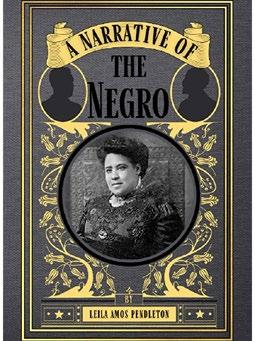
In 1915, she published “An Alphabet for Negro Children,” and later stories about a character named Sallie Runner in Crisis Magazine.
Aunt Sallie’s Sheaves, and Our New Possession - ‘The Danish West Indies both published in 1917. In 1921, she published an autobiography about Frederick Douglass and two short stories
published in the Crisis Magazine, “The Foolish and the Wise: Sallie Runner is Introduced to Socrates” (1921). and in “The Foolish and the Wise: Sanctum. Meets Cleopatra” (1922). In “The Foolish and the Wise,” through Sallie (the main character), Leila Amos Pendleton depicted how white people have presumed to, “own” not only human beings, but all significant human attainments, and have complacently assumed that anyone who achieves a great deal must, be white. Her stories stressed the intellectual and political accomplishments of individuals of African descent.
Leila Amos Pendleton’s, “A Narrative of the Negro,” was a complete chronological history of African and African-descended peoples, The textbook detailed the chronology of African Americans’ experiences and achievements from ancient Africa through the early 1900s in U.S. history. Her textbook was the first work that exposed African descendants throughout the diaspora and circumstances in Black history.
The preface describes the book as a ‘family story’ to the colored
A Narrative of the Negro Leila Amos Pendleton (Author), Smidgen Press (Contributor)children of America. The intended audience was African American students who had been taught little about the accomplishments of African and African-descended people. According to Leila Amos Pendleton, she conducted her research at the Library of Congress in the District of Columbia, university libraries at Harvard and Yale, and the Boston Public Library. She aimed to challenge the sub-personhood status and inferior racial theories African Americans were being taught in schools and society. She wanted to compel African American students to advance their study of Black history and culture and strive for academic advancement. Leila Amos Pendleton is particularly attentive to the development of educational opportunities for Black people in the U.S. Her work details the strides made despite setbacks such as attacks on teachers and students, the violation of school buildings, and lawsuits meant to shut down schools.
Passing the history of Africans and African Americans on to future generations was paramount to her. Throughout the narrative, she lauds the accomplishments of individuals of African descent from ancient times through the early twentieth century. She also provides short biographies of individuals she considers notable and devotes longer sections of the narrative to creating heroic portraits of well-known people such as François-Dominique Toussaint Louverture a prominent leader of the Haitian Revolution and Fredrick Douglass, an African American who escaped enslavement and became an abolitionist and statesman. She praised the contributions of Black soldiers and included a long list of prominent Black artists, musicians, writers, and scholars. She felt the narrative was her most noteworthy accomplishment. It praises the accomplishments of individuals of African descent from ancient times through the early twentieth century. Throughout her career, educating and lifting as she climbed, were at the forefront of her life.
Robert L. Pendleton died July 31, 1929, preceding his wife in death by nine years. Leila Amos Pend-
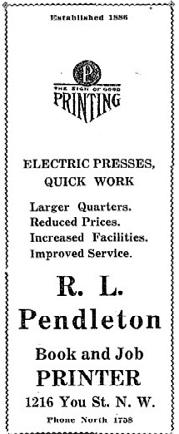
leton was called to her heavenly reward on Wednesday, December 7, 1938, at her residence at 1825 11th Street, NW, Washington, DC. Her remains rested at Frazier’s Funeral Home at 389 Rhode Island Ave. NW, Washington, DC. Officers and members of Prince Hall Chapter No. 5, OES-PHA were requested to attend the funeral services of Past Matron Pendleton, by Worthy Matron Georgie S. Johnson, Worthy Patron Ernest M. Dickerson, and Mary M. Hutchins, Secretary.
The members of Richard Howell Gleaves Assembly No. 2 Order of the Golden Circle were requested to attend the twilight service of Past Loyal Lady Ruler Leila Amos Pendleton at Frazier’s Funeral Home on Thursday, December 8, 1938, by Loyal Lady Ruler Susie Wallace and Loyal Lady Secretary H. Rebecca Beason.
Leila Amos Pendleton was survived by her five brothers: James Ralph, Ernest, Ferdinand, and Claude Amos.
Leila Amos Pendleton’s remains were transported Friday, December 9, 1938, to St. Luke’s Episcopal Church, 15th and Church Street NW, Washington, DC where her funeral services were held at 2:30 p.m. She was interred next to her beloved husband at Columbian Harmony Cemetery. Leila and her husband Robert Pendleton were among the 37,000 decedents who were presumably exhumed and moved to National Harmony Memorial Park where they were reburied. Records indicate that between May - November 1960, the Pendletons were reburied. However, their headstones were among the thousands that were sold as scrap or rip rap and used to secure the riverbank of the Stuart Plantation, which was built in 1795. The tombstones are on a 1400-acre conservation easement site on the banks of the Potomac River, in King George County, Virginia.
Leila Amos Pendleton and her beloved husband ILL. Robert Pendleton 33° are buried side by side at National Harmony Memorial Park in Landover, Maryland in unmarked graves. It is the desire of the Robert and Leila Amos Pendleton Committee to honor the Pendletons, who, for decades,
gave unselfish service to the Masonic bodies of the District of Columbia. We seek sponsorship and support to help us complete this project by the Spring of 2024. For more details concerning donation, contact Chair LL Catrice R. Vandross at catricevandross@gmail. com or Co–Chair PSGLLR Venecia C. Bessellieu venecia1@comcast. net. Checks should be written to: The Pendleton Project.
Photo Credit: Special Collections, Firestone Library, Princeton University | https://graphicarts.princeton.edu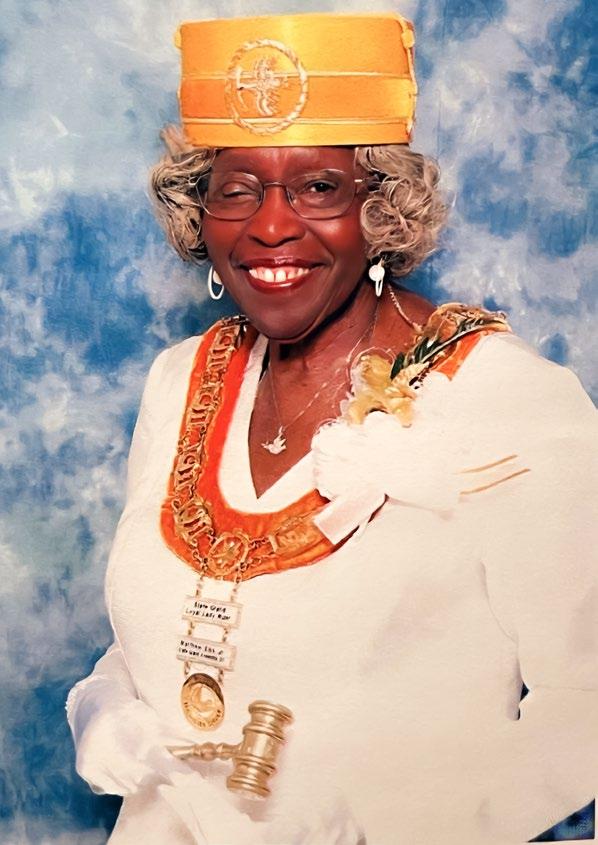
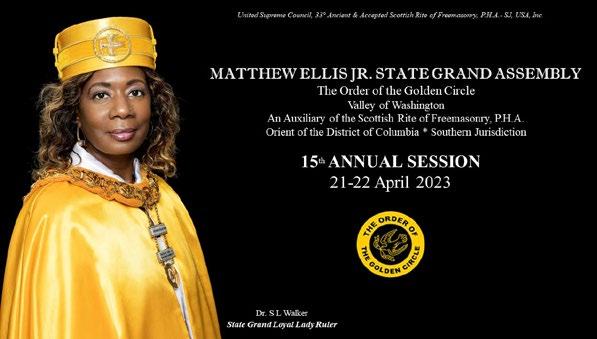
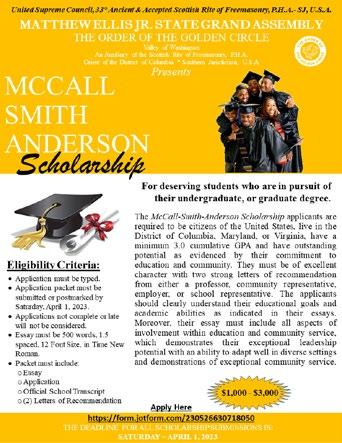
The first step into Freemasonry and the Order of the Eastern Star (OES) bring both a man and a woman through a door that leads them to a better path for their lives, but later, there is a second door that opens and reveals to them a whole new universe of opportunities that can be discovered through entering the Scottish Rite. Some look at Freemasonry or the OES as a complete home, but if you want to learn more about them, know more about them, and enjoy them more, you must live in every room. Most have learned that Scottish Rite is a big, beautiful room in Masonry, but you can’t close that first door and think you’re getting all of Masonry. You must want to experience the entire house. Not progressing beyond the Blue Lodge is like watching the first season of your favorite TV show and then not watching any of the following seasons. You miss the supporting characters that get added later and you don’t get the extra plots and twists that happen. The Blue Lodge is the place where you receive your bachelor’s degree, but many
Masons and Eastern Stars want more. Many of them want new experiences and to be able to continue an advanced education, and they know they can only find further light by way of the Scottish Rite.
Greetings, distinguished members of the Orient and all beyond who are reading. I welcome you all and thank you for taking the time to peruse this interview. What an honor it is to receive permission from the Most Illustrious Commander-in-Chief and Deputy of the District of Columbia Orient, Eric Konohia, 33°, to interview the apex of our leadership, which includes the buy-in from the State Grand Loyal Lady Ruler, Shelly L. Walker, Ph.D. Our Leadership understands they must be willing to be accountable and thorough enough to make themselves vulnerable to answer essential questions that will identify the long-term plan that will help our Orient successfully achieve its goals. I am confident to say you will be pleased with the answers you read below, and so without further ado, Ladies first:
I am a native of Pittsburgh, PA who is the youngest of a blended family of five boys and five girls, and I am married with two sons. I was educated in the public schools of Pittsburgh, PA, have a Bachelor’s degree in Psychology, with a minor in Political Science and Sociology from Troy State University. I also have a Master’s degree in Psychology with an emphasis in Marriage Family Therapy from Chapman University, and a Doctorate’s degree in Educational Psychology from Capella University. My published thesis is entitled: The Lived Experiences of Teachers as They Describe Their Values and Ethics Within the Educational School System. Author of Mental Thoughts Life’s Thoughtful Thoughts to Think About, and co-author of Her Story is My Story Her Truth, My Healing, and Earned Not Given.
I am an active member in several community organizations, including the Order of the Eastern Stars, the Daughters, which is an Auxiliary of the Ancient Egyptian Arabic Order Nobles Mystic Shrine, the Order of the Golden Circle, and Delta Sigma Theta Sorority, Inc.

Before getting married and following my husband’s military service career, I began my professional career as a Sexual Assaults Counselor in Pittsburgh. I worked as a Counselor helping girls who were physically and sexually abused, and as Instructional Aid for the School for the Deaf and Blind.
I serve as a Navy Transition Program Analyst and I am the CEO of Theories of Life Counseling Services as a Marriage Family Therapist, providing counseling and mentoring services, serving as a motivational speaker to all ages, to include being an advocate for Domestic Violence at Fear2Freedom Alliance. I am a person committed to serving others.
What year were you initiated in your Chapter? Tell us when and how you joined the Assembly.
My Masonic journey started, in 1998, in Morning Star Chapter No. 47, the Order of the Eastern Star, Prince Hall Affiliated (PHA), Bethlehem Grand Chapter of Florida where I became a second-generation Eastern Star (three of the heroines; daughter/wife/mother).

My husband Grand Inspector General, Leslie P. Walker, Sr., 33°, is a Past Commander-in-Chief, and my two sons Leslie Walker, Jr., and Julian A. Walker are both Master Masons. My parents are Brother Nathaniel Thomas, Sister Helena Thomas, Father-in-law, the late Grand Inspector General and Past Master Henry L. Walker, III, and mother-in-law the late Past Matron Annie Walker. Prior to serving as Past Matron (2017), Ruth C. Smith Chapter No. 8, I demitted from Florida, into Audrey Robinson-Underwood Military Chapter No. 15, Georgiana Thomas Grand Chapter, O.E.S. of District of Columbia, (2005-2016). I was initiated into the Order of the Golden Circle in 2005. I served as Loyal Lady Ruler (2014), Henry A. Dove No. 15, and is currently serving as State Grand Loyal Lady Ruler (2021-Present) of Matthew Ellis Jr. State Grand Assembly, Valley of Washington, Auxiliary of the Ancient and Accepted Scottish Rite Freemasonry, P.H.A., Louis W. Roy, Sr. Council of Deliberation, Orient of the District of Columbia, Southern Jurisdiction.
What have you done to become better in the last year?
While serving within the past two years, the members of the State Grand Assembly have helped me collect and raise over $5,000 in baby supplies for children in the House of Ruth Domestic Violence Kid Space Center located in Southeast, Washington, D.C. I also assisted with collecting $3,000 in funds for the McCall, Smith, Anderson Scholarship.
Describe your leadership style and state whether you think it is effective.
I try my best to lead with a balance of compassion, respect, flexibility, transparency, and accountability. I lean heavily on the accountability attribute of people, which sometimes is faced with a lot of pushback. It is very hard for me to go against my nature, and as a therapist, I refuse to be an enabler of disrespect and misconduct.
What would be most impressive to you for an ideal Loyal Lady to possess before coming into the Assembly?
The most notable standards a Loyal Lady should possess before wanting to become a member of the Order of the Golden Circle should be empathy and integrity, which should be common practice for all.
What does the Golden Circle represent? What is the biggest misunderstanding?
To me, the Order of the Golden Circle represents modesty and authentication. If people join looking for recognition, they will be sadly disappointed. The biggest misunderstanding is the Order of the Golden Circle is primarily about charity, teaching, and learning.
How clear is your vision for what the Assembly’s responsibility should be like during your tenure and in the future? Is the direction that the Assembly wants to go in clear and understandable?
I do not believe in reinventing the wheel. My vision for the State Grand Assembly is to carry forth the foundation that was already charted for the organi-
zation, which is to do all good deeds with virtue and benevolence. The direction of the State Grand Assembly is clear and understandable, but sometimes hard for some to stay on the path of decorum and responsibility.
What do you feel is the biggest strength of the Assembly right now?
The biggest strength, in addition to my character, is following the vision of the founders of the Order of the Golden Circle. I am hands-on and considers leading by example to be the best demonstration.
What uncomfortable changes does the Assembly have to make in the next 5 years? What areas are you willing to let go of, shed, or eliminate? What makes you sure those are the areas?
If the Matthew Ellis Jr. State Grand Assembly wants to change for the better, it must be willing to let go of the old ways and embrace society and generational shifts. The State Grand Assembly must eliminate falling into comfort zones and closed-minded thinking. Although its birthplace occurred in the District of Columbia, the Scottish Rite is a national body of its own principles and virtues.
What obstacles lie in the path of the Assembly, and how do we remove them?
The State Grand Assembly’s greatest obstacle is itself. If the members are not willing to change, require accountability from each other, or recognize individuals that give unselfishly, the State Grand Assembly will lose good quality members.
What must be done to achieve alignment and commitment of key stakeholders, within the Assembly, to your strategic plan?
To continue to attract good quality members, the best strategic plan is to be transparent, have good lines of communication, timely planning, fair recognition, and empower invested members.
How has the reality of being State Grand Loyal Lady Ruler differed from what you imagined before being elevated to the position?
The reality of being State Grand Loyal Lady Ruler has not differed since being elevated to the position.
How will you train and develop the subordinate assemblies? Does the Assembly have the in–house skills to execute your vision properly?
The key to helping the Subordinate Assemblies develop is to ensure that there is a continuum of ample training and that learning sessions are provided. The State Grand Assembly has a wealth of Past State Grand Loyal Lady Rulers with a wealth of knowledge and history of the Order of the Golden Circle.
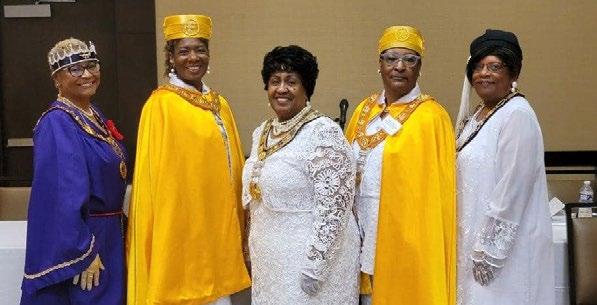
How well does the Assembly utilize its people as an asset to help it improve, stay competitive, and strategically meet goals? Are people used efficiently, or is talent wasted due to a lack of effective strategy?
From the moment I became the State Grand Loyal Lady Ruler, an open-door policy has been offered to the members to feel free to offer their suggestions, skills, and interests.
With respect to the Assembly, what steps are needed to close the gaps between now and where we want to be? What are the implications of this?
Huge steps have been taken to try to close the gaps between now and where the State Grand Assembly
needs to be. The State Grand Assembly has been successful in having its Administration Bylaws & Protocol Manual updated and approved by the new United Supreme Council Secretary General.
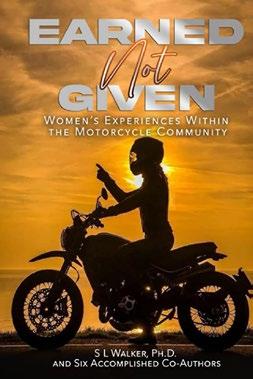
What is the best way we can measure success against the Assembly? How are you defining the boundaries of the Assembly?
Every organization should have a means of statistical data to measure rewards and losses, not a method of comparison and competition. Each member must answer for him or herself, and if each member applies their best offers, there are no boundaries, only endless possibilities.
How do you want the Assembly to remember you when it is your turn to leave the seat?
When I leave the seat of State Grand Loyal Lady Ruler, I would like to be remembered as the same respectful leader I was when I came in.

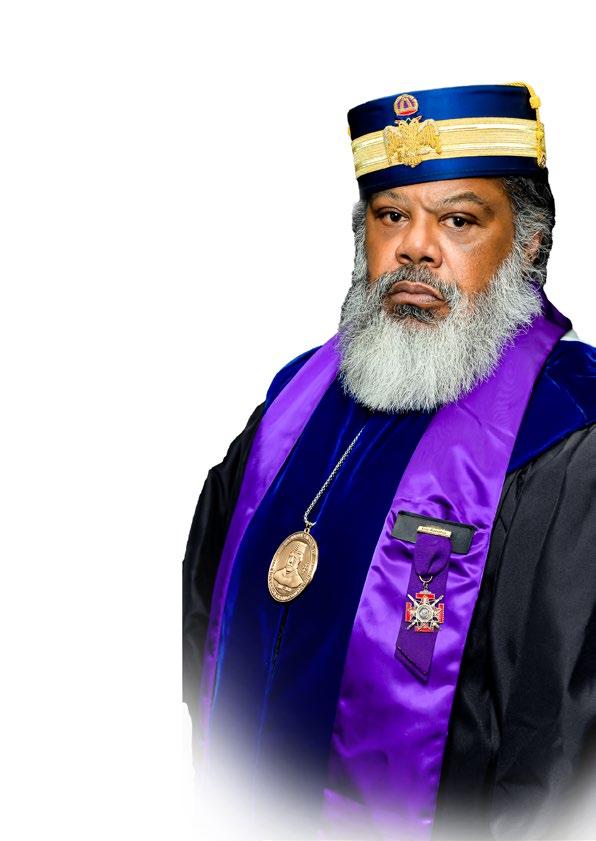
Tell us about yourself.
My name is Eric Konohia and I have been married to my wife Diana Konohia for 27 years, and we have 3 boys, Philip Kaleookalani, Noah Hiapoihilani and Matthew Ioela Kealoha. I have been in business for myself since September 2001 overseeing the protection of Fortune 100 and Fortune 500 clients domestically and internationally. I am a former Trooper with the Maryland State Police and received my B.A. in Criminal Justice / Criminology with a minor in Sociology from the University of Maryland.
I am a direct paternal descendant of the House of Kamehameha. I grew up under my father’s daily guidance and tutelage in the Hawaiian ways, traditions, and philosophies that I discovered waiting for me beneath the veil of allegories in Masonry. These traditions, ways of worship, and how nature plays a major impact paralleling our lives are steeped in the Hawaiian culture. I have been fortunate to find familiar friends (philosophies an traditions) waiting for me at every turn of my Masonic journey.
My greatest accomplishment is being a father; however, that is probably better described as my greatest blessing. I think ascending to my status, in my usual vocation, where I was recognized as single-handedly changing the face of the industry is an accomplishment that I am personally proud of. It is that same process I used in trying to inspire members of this Orient to turn the District of Columbia around.
What year were you raised in your Lodge? Tell us when and how you joined the Consistory.
I was raised to the Sublime Degree of a Master Mason on the 10th of Elul 5775 in Fellowship Lodge No. 26. I respected all the Past Masters in my lodge for their commitment, knowledge, and wisdom in the Craft. One Past Master, in particular, Past Master, Past Commander-in-Chief, Grand Inspector General, A.C. Cole, 33⁰ told me to reach out to him if I decided to go into the Scottish Rite and the Shrine. In 2015 after I took the Master Mason’s proficiency test, I asked him for a petition to Jonathan Davis Consistory No. 1. I submitted the petition and received all my degrees over a period of 4 to 5 months.
On the day I was advanced to a Sublime Prince of the Royal Secret I witnessed something that changed my trajectory in the Ancient and Accepted Scottish Rite (AASR). That was the Encampment delivered by Grand Inspector General (GIG) Chauncey Forth, 33⁰. I was floored to see that part of the ritual being performed. Having done the middle chamber twice, at that time, this part of the ritual caught my attention. During that degree, GIG A.C. Cole, 33⁰ was sitting as Second Lieutenant Commander and noticed that I was in awe of what was being performed. Little did I know, at that time, he was not the only one that saw me floored by it. I would find out later that Sovereign Grand Inspector General (SGIG) Marcus James, 33⁰, who at the time, I didn’t know very well, said he saw me mesmerized by it.
GIG Cole, 33⁰ went to Deputy Paul Barry, 33⁰, and told him to put me in line to take over the “Camps” when GIG Forth, 33⁰ was ready to give it up. In 2016, I walked the Camps for the very first time in front of the Orient during the 32⁰ and received a standing ovation. I was later informed that I was the third person to walk the camp in the last 50+ years including Most Worshipful Past Grand Master (MWPGM) John D. Howard. That one single event, from my perspective, separated me from the rest of the Sublime Princes in the Orient and not too long after that my name started vibrating off the aisles and arches of the United Supreme Council.
Almost 2 years to the date in 2017 GIG A.C. Cole, 33⁰ asked me if I wanted to receive my 33⁰ to which I said yes. In October 2017, I was elevated to Grand Inspector General and elected Vice President of the SGIG Howard L. Woods Class in Jacksonville, Florida. In November 2017, I was nominated, elected, and installed as the Worshipful Master of my lodge and in that same month the Deputy for the Orient, SGIG Paul Barry, 33⁰ asked me if I could handle being
President of the John D.
Commanders of the Rite. I agreed to take the position knowing that the Commanders of the Rite had not met since 2015.
I called, in place, a special meeting and only four GIGs showed up. On that day, I appointed each of them as an officer of the Commanders of the Rite (COTR). The first constitutional meeting of the year was in January 2018. Prior to that meeting I emailed every GIG we had on the rolls and asked that they attend the next meeting to see my plan to revitalize the COTR. At that meeting, I had a PowerPoint presentation with one slide. It was an inverted equilateral triangle with the number(s) 33 upside down and with the letters T-R-E on the corners. I told them that was my plan. They bought into the plan, and I am happy to say that was when I had an opportunity to show my leadership skills in the Scottish Rite. In that same year, I was awarded Worshipful Master of the Year as well.
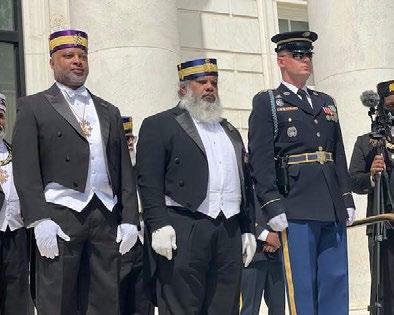
In 2018 I began lecturing for the registered attendees, at the United State Council (USC), during the Annual Session, and in the same year, I was selected as a volunteer on the Ritual and Ritualistic Affairs Committee. In 2019, I published my first article in the Scottish Rite Bulletin and was placed on the staff as a writer. Also, in 2019, I was honored to lecture in front of the candidate class at the USC Annual Session in Alabama. As fate would have it, I walked the camps while two other fraters, SGIG Patrick Worlds, 33⁰, and GIG Solomon Burgess, 33⁰, (both from the Orient of Florida) exhibited the signs, grips, and words as I walked the camps. At that same Annual Session, I was placed on the Ritual and Ritualistic Affairs committee as a committee member.
Due to Covid-19, there was no Annual Session in 2020. In May 2021, I was appointed Deputy for the
HowardOrient of the District of Columbia by Sovereign Grand Commander (SGC) Dr. Corey D. Hawkins, Sr., 33⁰. In October 2021 at the 45th Triennial and 135th Annual Session in Memphis, TN., I was coroneted SGIG and 2 days after I was coroneted, I conferred the 33rd and last degree in Masonry to over 500 Fraters with a degree team that I hand-picked from D.C. They were GIG H. Donovan Colding, 33⁰ (Ceremonial Lieutenant Grand Commander), GIG Russell Hairston, 33⁰ (Ceremonial Captain of the Guard), GIG Vincent H. Fadis, 33⁰ (Ceremonial Master of Ceremonies) and GIG Marcus Crooks, Sr., 33⁰ (Ceremonial Grand Prior).
I was extremely proud of this opportunity as it was the first elevation under the leadership of SGC Hawkins, 33⁰, and the last degree that MWPGM, SGIG Quincy G. Gant, 33⁰ would witness as Grand Master. We practiced twice a week for 5 months and delivered the 33⁰ in D.C. ritualistic fashion. We were all confident that we got the job done, but it was the comments during the degree and afterward that made us feel we surpassed expectations.
What have you done to become better in the last year?
I have been studying Jewish mysticism for over 10 years as a student of Kabbalah and how it ties into Hawaiian traditions and Masonry, particularly Scottish Rite Masonry. The biggest part of Kabbalah is transitioning from a vessel of reception to a vessel of bestowal. In the past year, I think I have been better at giving rather than receiving in addition to being more tolerant of others because the underlying lesson in the A.A.S.R. is tolerance.
Describe your leadership style and state whether you think it is effective.
I am a letter of the law kind of leader with a larger emphasis on STANDARDS. Raising the STANDARDS in my usual vocation is what got me recognized industry wide. I feel that standards are what makes some institutions great and others just survivors in a particular space. In many cases, as it was here when I took the helm. We had gotten so far away from any standard that no one knew what the A.A.S.R. standard was. I hit the HARD RESET button and made it plain, “If you don’t know what the standard is or was, we will start with this. If you cannot get away with it in the South Hall, you will no longer get away with it in the North Hall!” Without saying anything further, you could tell that the membership had a baseline of where we would start.
What would be most impressive to you for an ideal Frater to possess before coming into the Consistory?
That’s easy, he needs a solid foundation in the first three degrees. A new Frater will find himself lost and a bit disconnected if he does not have a solid understanding of the Hiramic Legend, all his tools, lodge
symbolism, and implements. Past Sovereign Grand Commander (PSGC) Albert Pike said, “The true mysteries of Masonry are purposely kept from the Craft Mason.” He is right; however, without a strong foundation in the Craft degrees, you will not see, pick up, or understand the difference between what is being said and what is really meant.
In my first workshop with the newly advanced Sublime Princes of 2023, I showed them specific instances where you are told certain things but because you are not aware of the sleight of hand, you never see what should have made you ask questions.
What are the biggest challenges facing our Orient, both Consistory and Assembly?
From a consistory standpoint, it’s impressing upon the body that proficiency, of all officers, will be taken seriously, and unlike my predecessors, I will not be hesitant to replace anyone until the right people are in place. When I became the Deputy, we still had members bringing their rituals in the north hall to assist them in opening and closing. This was a terrible habit that had no consequences, and it became the norm. Secondly, some of the consistories are not recruiting as they should be. They need to open the dialogue in their lodges and other houses. If our members can get new Fraters in the door, I will close the deal on where they will want to spend their time. I am a member of every house, and I will tell you that NO OTHER house in our temple teaches these degrees and the true meaning of the symbols. Sure, we all have schools of instruction, but those are part in parcel for preparing for the Master Mason’s exam or preparing to put on the 3 GREAT PLAYS: Entered Apprentice (EA), Fellow Craft (FC), and Master Mason (MM) degrees. We breed and train more thespians than making better men. The Orient has taken over the fundamental promise of Masonry. We are in a position that allows us to go after ONLY GOOD men in the lodges and make them better men through the AASR.
In the Assemblies, the situation is the same. There is a small number of Loyal Ladies recruiting into the Order of the Golden Circle (OGC). Our Assemblies are replete with sisters who did and are doing great work in the OES Chapters, but they are in a repeat cycle, in the assemblies, and are unfortunately in and out of the chairs. Lastly, we need to encourage more speculative and esoteric teaching in the OGC. The literal meaning of the ritual is veiling a treasure trove of beautiful lessons that can be applied to life.
How clear is your vision for what the Orient’s responsibility should be like during your tenure and in the future? Is the direction that the Orient wants to go in clear and understandable to both the Consistory and the Assembly?
I am absolutely certain that my vision and plan was and is clear. I have a saying, “We will continue to
raise the STANDARD and apply increasing PRESSURE to make it uncomfortable to exist outside the STANDARD. We are the birthplace of the United Supreme Council Southern Jurisdiction (USC-SJ), and we should comport ourselves as such. My intention is to stay on the cutting edge of whatever we do and if we aren’t first at it, we will do it in such a D.C. fashion that you will forget who did it before us. If you have been paying attention to what we have accomplished in the first 3 months of this year, you will see that this Orient has all eyes on us. That is a testament to the membership understanding the assignment and buying into the plan. There is so much potential here in D.C. but what we do and why we do it must make sense because it will have a huge effect across the Southern Jurisdiction.
What do you feel is the biggest strength of our Orient right now?
Our biggest strength in the Orient is our EDUCATION in the 2 Workshops. One of them is exclusively for only 33⁰ Masons and the other for only 32⁰ Masons. The whole premise of an Eagle’s Club separates us from most of the other Orients in the Southern Jurisdiction except Florida. Finally, our Sublime Princes and Knight Commanders Court of Honor (KCCH) have a sense of direction, responsibility, and ownership in the Orient. This is a far cry from the recent past. It used to be a standard operational procedure if you got advanced to 32⁰, and you were left to your own devices on what you learned and where you learned it from. It was a very unsettling feeling.
Our workshops are the reason Master Masons want to be in the AASR. When they see you and others like you walking around in Godfidence, they want what you have. The other part to this is that we a have an Orient of working SGIGs which gives every Frater a tie into the USC. Our Sovereigns in the District of Columbia are the walking example of what Scottish Rite Masonry stands for. I jokingly tell others that the best advice I received in 2017 when I went to the USC Annual Session to be elevated was this, “Pay attention, but watch how the Sovereigns MOVE”. You cannot explain it until you see it for the first time. In D.C. you see it every day. Whether they are regaled in AASR accouterments or in Grand Lodge regalia. A USC-SJ Sovereign moves differently. His presence is noticed. When he departs, you are better off from the moment he was there.
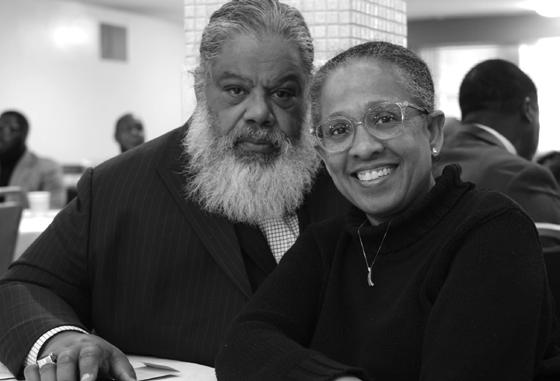
What uncomfortable changes does the Orient have to make in the next 5 years? What makes you sure those are the areas?
I am thinking about applying a bottom line to each consistory. For example, every Consistory must bring in a minimum of 10 Fraters a year or be assessed for every missed opportunity. I haven’t thought it through yet but something to that effect is in the works.
Sometimes everyone will need to come to grips with the fact that most of the rubbish pile needs to stay there and will not be brought back to the temple for any usage. For those who left the GREAT work to
dumpster dive, that’s where we will leave you. I will not waiver on either of these points because both are dependent upon us thriving and not just surviving.
What obstacles lie in the path of the Orient, both the Consistories and the Assembly, and how do we remove them?
We are our own obstacles at this point. Commitment, diligence, and hard work are what got us this far but there is no time to take off. Those who fail to meet the mark will have to be inspired by more tenacious Fraters. I see how excited brothers and even sisters are with the whole thought of doing anything they want to do in other houses and dismissing their obligations. This is not what Masonry is about. For everyone that wants this to be a social club, there are two that want to be a better person.
What must be done to achieve alignment and commitment of key stakeholders, within the Orient, to your strategic plan?
The bottom line is – A sense of Pride in that you were an agent for the change, and that your DNA played an instrumental part in leaving this Orient in a better place than we received it. We are there now but the work has just begun. Everyone in the Orient has a stake in the success of the AASR and the Rite. My responsibility is to ensure that all Fraters and Loyal Ladies feel they have the same vested interest in our success. When the Orient wins…. WE WIN!!!! And we are definitely winning.
How has the reality of being Most Illustrious Commander-in-Chief Deputy for the Orient different from what you imagined before being elevated to the position?
The biggest reality check was that No one expected that I would be appointed as Deputy for the Orient. The second biggest reality check was the responsibility that came with the position. I AM the direct representative of the SGC in the District of Columbia. No one else holds that responsibility. Which means that this Orient must always, from sunup to sundown, mimic his vision and plan. I ask myself daily, does D.C. represent our SGC’s vision and plan? I am comfortable in reporting, “Job well done again today Fraters and Loyal Ladies of D.C.
How will you train and develop the subordinate Consistories? Does the Consistory have the in–house skills to execute your vision properly?
Slowly but surely, we have been putting in place those procedures and protocols that are AASR specific. For instance, when you receive certain AASR members, in the Consistory, they are to be received under lights and swords. That never happened at regular rendezvous even though it is part of the protocol. I am reinforcing that. I have a tight group of Executive Officers from KCCH to SGIG that are constantly training members and giving wise counsel whenever they see anything that needs to be corrected. Eventually, this will become infectious and self-correcting. Consistories are the equivalent to what a lodge is to Craft Masonry. The individual overseers in each consistory are tasked with making sure the standard is always kept.

How well does the Orient utilize its people as an asset to help it improve, stay competitive, and strategically meet goals? Are people used efficiently, or is talent wasted due to a lack of effective strategy?
Every Frater has a place in this Orient. Additionally, every Frater must participate if he wishes to be acknowledged for the next rank. The old “Family and Friends” discount is over. You will earn the KCCH and every 32⁰ must stand out from the rest to be recommended for the 33⁰. Under my leadership, if someone is afforded the investiture or elevation, he will be an exceptional Frater and a standout. Part of my plan, going forward, is that every outgoing Commander-in-Chief (CIC) will spend his next year as the overseer for his consistory. That maintains continuity in leadership because he just passed.

If you are interested in accompanying me or my representative on any of the upcoming visitations.
May 26 – 30, 2023
[USC 33° AASR NJ, USA] Denver, CO
July, 28 – 30, 2023 [FL COD Workshop] Jacksonville, FL
We are now offering advertisement slots for the Chokmah Newsletter. Chokmah is the official The Official Publication of Valley Of Washington, Orient Of The District Of Columbia, Louis W. Roy, Sr. Council Of Deliberation A∴A∴S∴R∴ PHA∴SJ-USA and is published six times a year (bi-monthly).
If you’re interested in boosting your product or service recognition, consider taking an ad out in this publication!
For greater exposure to your business, please contact our advertising team at chokmah@lwrsrcod.org
the seat and knows firsthand the pitfalls and responsibilities of the chair. He, in turn, will be evaluated on his performance and report to the Overseer everything regarding that specific consistory.
With respect to the Orient, both the Consistory and the Assembly, what steps are needed to close the gaps between now and where we want to be? What are the implications of this?
As I mentioned before, recruitment needs to be addressed. My fear is that I will have to judge myself on what tolerance will look like as I set forth the plan. This is my biggest challenge because the attention to detail and membership is a direct result of the attitude taken in subordinate lodges and chapters. The difference here is that the Fraters are learning but not focusing on helping their lodges with what they learn, and I honestly feel the Loyal Ladies are reluctant in bringing in new sisters during this “reset” phase in the OGC.
For the Fraters, I am not referring to going back to their lodge and teaching lessons from the 4⁰ to 32⁰ because that would be violating their obligation; however, I am teaching them how to unravel some of the allegories in the Craft degrees and help the Worshipful Master’s by lecturing on that. The Orient is not a silo but a means to an end. Each of us are responsible for lifting our brothers and sisters as we climb.
What is the best way we can measure success against the Consistory? How are you defining the boundaries of the Consistory?
My measuring rod for success in each consistory is membership, charity, workshop attendance, and exposure. If the membership is doing those four things, it will self-perpetuate itself. Membership will only increase when Master Masons want to be a part of something GREAT. Our charitable endeavors give exposure to the AASR in the community, which shines a light on the GREAT work of Masonry. This, in turn, increases exposure and membership. The workshops are our secret weapon because Master Masons want to attend, but they cannot unless they are recruited into the membership.
How do you want the Orient to remember you when it is your turn to leave the seat?
I pray that I gave everyone the requisite tools to become better individuals in their own lives. Secondly, I left the Orient in a better place than I received it. Lastly, the Konohia name made a difference.
SOVEREIGN GRAND INSPECTOR GENERAL
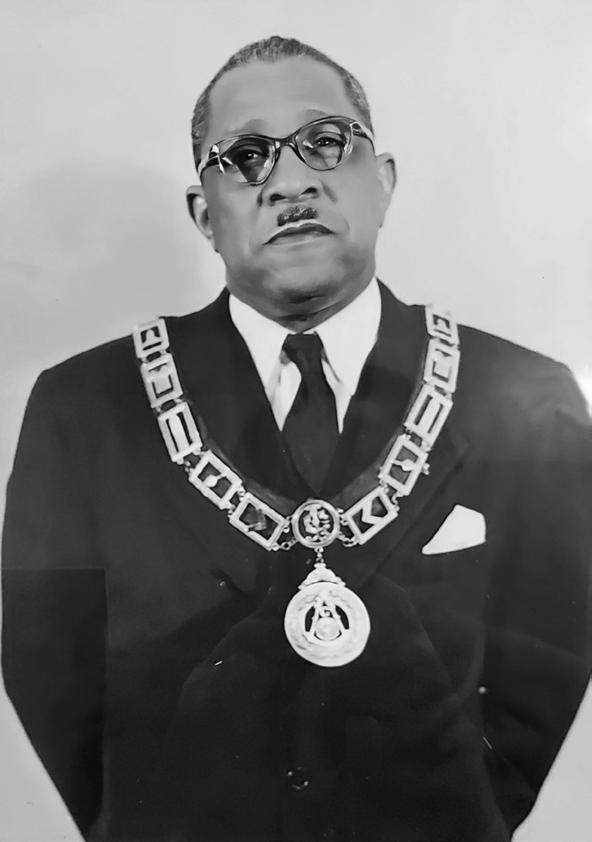
Who is teaching Master Masons what a good man looks or acts like? What is the standard, or maybe, that’s too much to ask for? So, what is the baseline image, character, personality, or behavior of a “good man”?
Do all Master Masons agree on that? Let’s say you find the elusive “Good Man”, what is it that Ancient Craft is doing to make him better?
It is safe to say that the universal promise that Masonry makes is hidden in the veiled allegories and symbols of the rituals. Would you agree? If that is the case, then who is teaching the lessons of the allegories and symbols? Let’s say that it’s not in the rituals; then what is it that is so special about Masonry that it is supposed to live up to its end of the deal/promise?
I contend that it is, in the ritual. I also argue that ancient craft masonry has become more satisfied with conferring degrees with such ritualistic precision that we forget that the initiatic experience is what prompts the question, “What does this mean?” This problem isn’t localized or limited to PHA.
The paradigm shift is in the An-
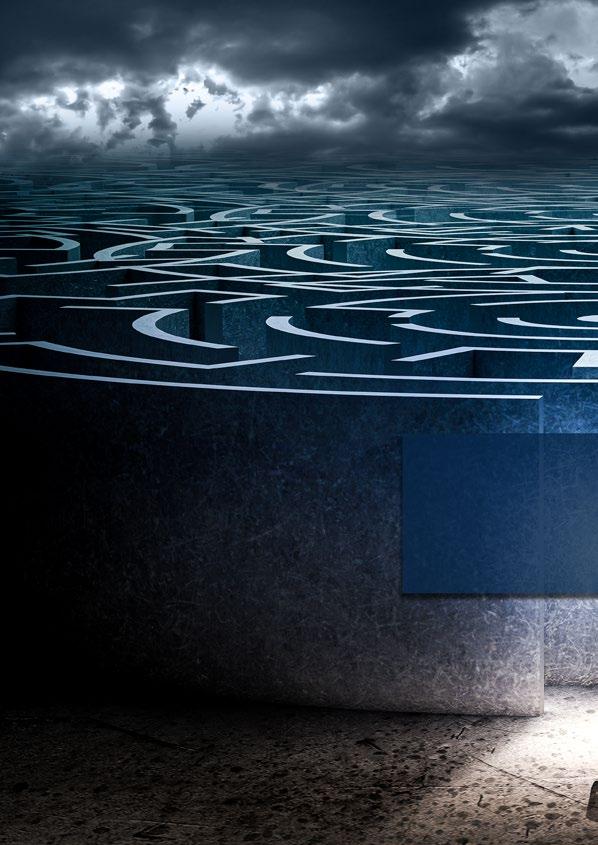
cient and Accepted Scottish Rite. Unlike our forefathers and ancestors that joined the Scottish Rite, today’s Master Mason is coming to the Rite yearning to learn. They are learning what they are not taught in the Symbolic Lodges and, as a result, receive further light. We are now in a position where we are being exclusive in our recruitment. Why, you ask? Because everyone is not ready to be a Scottish Rite Mason. You have to have a basic understanding of the Craft degrees to grasp the information of the College of Freemasonry. Of those men with a good understanding, we only select the Good Men/ Brothers. Therein lies the paradigm shift. The AASR is now doing what has eluded Craft Masonry’s first duty or Universal Promise. We (A.A.S.R.) are recruiting the Good Men and making them better. It’s not the best process for Freemasonry, but it is working.
Part of the draw to peak interest is the statement by Past Sovereign Grand Commander, Supreme Council “Mother Council of the World”, Southern Jurisdiction, Albert Pike.
“Making good men better,” is the commonly promise of Ancient Craft Masonry. Presumptively, to look for “good” men and lead them to men.
“The true mysteries Ancient Craft are purposely the Craft
ERIC KONOHIA, 33°
commonly accepted brand statement or Presumptively, Master Masons are supposed Freemasonry to make them “Better”
We exploit this statement because it carries more profound implications for every brother who thinks he is on the path of further LIGHT, when there was much more light, he was not afforded in his lodge. This is not necessarily the fault of the lodge; however, we have to take some of the responsibility for not encouraging studying and lecturing in the lodge where the gaps in logic become apparent.
Those brothers that come into the A.A.S.R. immediately are shown what they missed right in front of their eyes, and then we explain it and how they apply it to their lives. The other important part of this process is that we hold our members to a higher standard and responsibility of being a Mason, particularly a Scottish Rite Mason.
When they return to their lodges, they spread the word that we are teaching the lessons of Freemasonry. They are letting their lodge brothers know that the first symbol they are taught in the 4⁰ is where the wisdom of future generations discovered what was
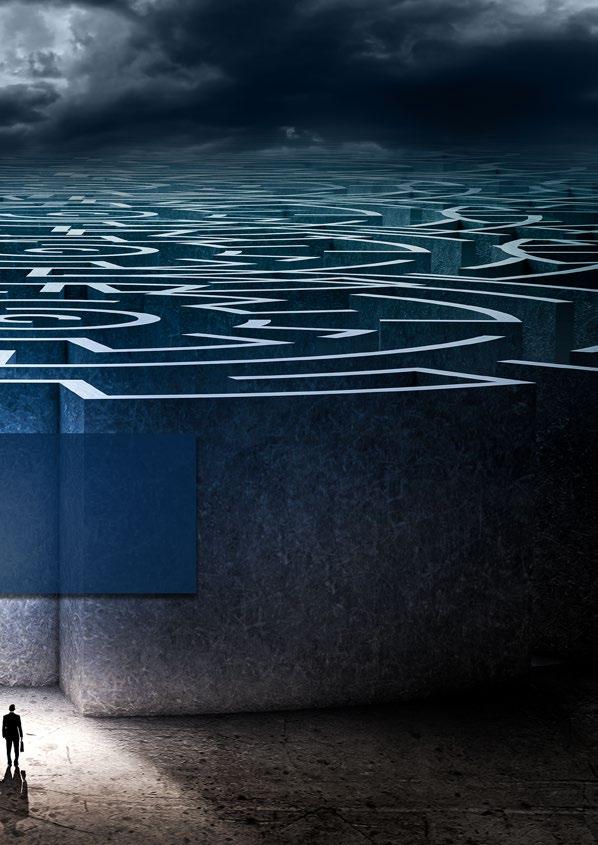
“Lost.” The adage and recruitment tool of another house, that you can only find what was lost “there” is dispelled. It is a great time to be a Scottish Rite Mason because our members can finally answer the question, “What does this all mean to me, and what is my responsibility here during this very short time called life?”
Decide today which direction you will symbolically traverse from that northeast corner, toward the LIGHT, or back to groping in Darkness from whence you came. If you decide to continue to advance toward the East, where you were given the charge, AND you are a good man/brother, the Ancient and Accepted Scottish Rite has what you came looking for.
Make the RIGHT choice for the RITE reasons and see any frater who is a member of Jonathan Davis No.1, James W. Banyard No. 11, Henry A. Dove No. 15, or Johnnie L. Doctor No. 18. If they tell you their Deputy is anyone other than SGIG Eric Konohia, you are in the WRONG PLACE.
mysteries of Craft Masonry purposely kept from Craft Mason.”
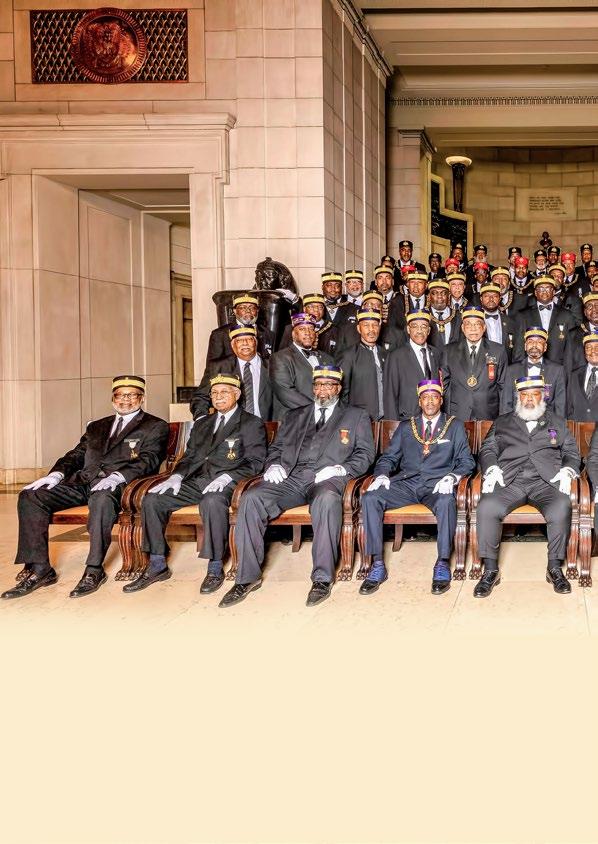
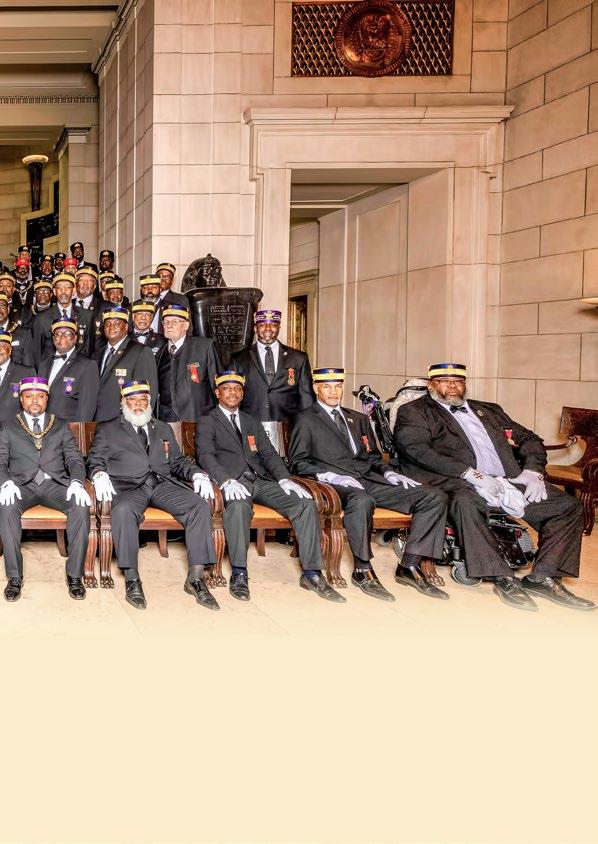
Since my appointment as Deputy for the Orient of the District of Columbia by SGC Dr., Corey D. Hawkins, Sr., 33⁰ in May 2021, I knew that I had to turn things around for this historic Orient and that the District of Columbia was rife with possibilities that would bring it back to its original respect and luster.
I decided that for our annual Council of Deliberation Annual Sessions, I wanted to change how we used to operate. In the past, we would finish our degrees on Friday so that our new class would be advanced on Friday, and the new Fraters would enter the A.A.S.R. at COD. I wanted this Orient to be a desired Orient to visit every 4th weekend of April, so in my mind, “Friday had to be the draw.” That was the plan as we advance. As a result of that, our 2022 Annual Session commenced on Friday, April 22, 2022, at the Tomb of the Unknowns with SGC Hawkins and me laying a wreath at the tomb with the other 3 regular/ recognized Supreme Councils in attendance. This was a historical moment for the District of Columbia, the USC-SJ, and those in attendance.
A month later, I represented our SGC at the first Grand Commander’s Summit at the House of the Temple (HOTT), Headquarters of the Supreme Council “Mother Council of the World,” 1733 16th Street, N.W. Washington DC. Out of this meeting was birthed the “Statement of Unity” signing of September 7, 2022. Also, at this Summit, during a break on day2, when I was speaking privately
with Grand Commander Cole, 33⁰ he mentioned in passing that no Prince Hall Mason has ever sounded the gavel in the Temple Room of the HOTT. Immediately, “DING, DING, DING” was the sound I heard in my mind.
I could hardly concentrate for the rest of the day. The first annual Summit was a success and we are all witnesses to the Statement of Unity signing. However, in my mind, there was one more piece of unfinished business.
I scheduled a meeting with Grand Commander Cole for November 8, 2022, at the HOTT for the sole purpose of asking the question, “Can I open my 2023 LWRSRCOD Annual Session in the Temple Room?” I sat in his office with him in the corner where he

had 2 beautiful Victorian Parlor chairs. These are the same 2 chairs that SGC Hawkins and SGC Cole agreed on regarding the KCCH investiture for members of the USC-SJ. I ushered the nerve to revisit his previous comment about the Temple Room and asked him if he would “consider” me opening my session in the sacred room.
SGC Cole’s eyes beamed at me with the same look, “DING, DING, DING” that I had previously experienced. Without hesitation, he agreed but I immediately knew that this moment was a continuation of his work for recognition and unity.
He turned towards the door of his private office that leads back into the reception area and called

During the Supreme Council’s session in October 1909, a resolution was passed to enlarge or extend the existing House of the Temple in Washington, D.C., or to erect a new one. This unanimously enacted resolution gave Grand Commander James D. Richardson “full power to do any and all things necessary and proper in connection herewith (that is the building etc.,) including the purchase of the necessary real estate and the erection of a suitable building, furnishing the same, etc.” (1911 Transactions, p. 115).
Grand Commander Richardson was deeply committed to building a new Temple so magnificent that it would be revered by all Scottish Rite Masons worldwide.
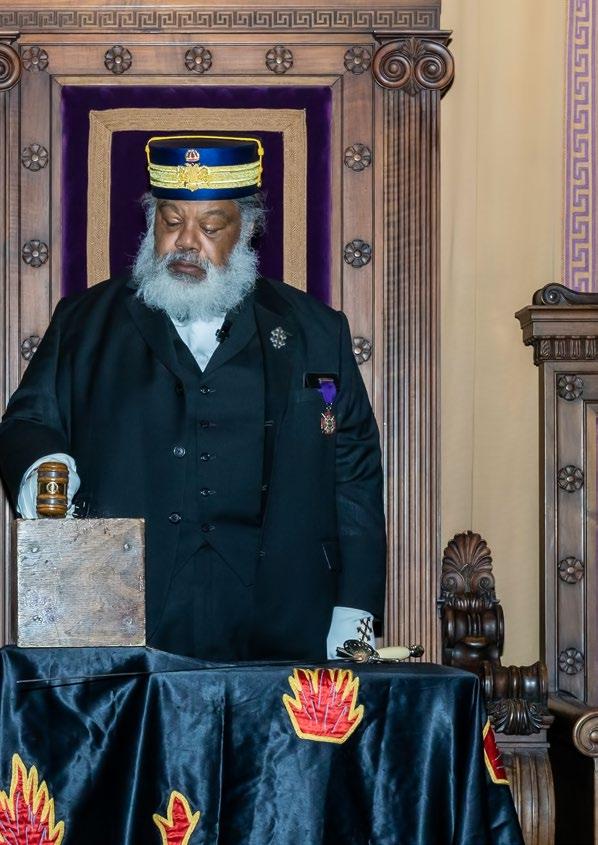
After reviewing numerous submissions by various architects, Richardson finally saw a design that met his vision of a majestic edifice to be the symbol of the Scottish Rite Mother Council of the World. Pope’s vision for the new Temple was based on one of the Seven Wonders of the Ancient World, the Tomb of Mausolus at Halicarnassus, Turkey.
Grand Commander Richardson accepted the basic design, and on April 16, 1910, he and Pope signed the contract to employ Pope to “complete the plans and supervise the erection of the new House of the Temple. Richardson instructed Pope to make “the new Temple as magnificent as art and money can make it” (Architect of Empire, p. 123).
The Grand Commander set May 31, 1911, as the day for the ground-breaking for the new House of the Temple—the 110th anniversary of the founding of the Supreme Council in Charleston, South Carolina. At 9:00 am on the 31st, Richardson turned “the first spade of earth in the building of the new Temple” (1911 Transactions, p. 124). In attendance were several members of the Supreme Council and numerous photographers and newspaper correspondents to record the historic event.
As the builders went about the work of excavating for the basement and foundations, Richardson arranged for an event to celebrate laying of the cornerstone on October 18, 1911.Pope took to heart Richardson’s commitment to create “the most beautiful Masonic building in the world.” (Architect of Empire, p. 126). Pope set out in earnest to create an elaborate masterpiece that would serve the Masonic ideal Richardson inspired.
The new House of the Temple, located at 1733 Sixteenth Street, NW in the District of Columbia was completed in October 1915. It is unfortunate that Grand Commander Richardson passed away on July 24, 1914, before he could see his vision fully completed. The honor of conducting the dedication ceremony and officially opening the House of the Temple went to the new Grand Commander, George F. Moore.
One hundred years later, the House of the Temple remains an emblem of greatness, but it needs our attention now. To restore and maintain its grandeur, we must attend to the hard work of renovating this historic building. Over the next five years, extensive work must be done, work that can wait no longer. Restoring a onehundred-year-old historical building requires a great deal of expertise and care. We need your support to accomplish this daunting task.
Courtesy of www.scottishrite.org
his Chief of staff, Office manager, Gatekeeper, et al, “Elizabeth, come in here with your notepad and listen to this.”
We briefly discussed how that day would transpire, knowing that I would have a specific plan for that day in the new year.
2 weeks before our Annual Session I scheduled a final walkthrough with Elizabeth Sizemore along with Knight Commanders, Mark Fair, Kevin Moultrie, Darryl Green, and Phillip Harrigan. Each Knight Commander was assigned to oversee a specific portion of that historic day. Our meeting was a success, and we were ready to go.
At 6:00 a.m. the officers and members of the Council of Deliberation boarded the bus at our host hotel and headed to the HOTT. KCCH Phillip Harrigan, who I assigned as the Lead Site Frater, informed us that Elizabeth and Daniel Matsumoto had opened the building and were awaiting our arrival.
We arrived at approximately 6:45 a.m. and entered the main doors on 16th Street which places you in the hall where the Statement of Unity was signed. As you enter you cannot help but read “Salve Frater” (Welcome Broth-
er) on the leg of the marble desk where the famous document was signed by the 4 Sovereign Grand Commanders.
We took the main staircase up to the Temple Room, each step taken slowly with deliberate intentions while absorbing every inch of this magnificent palace. As we entered the Temple Room, I could tell that the breadth of the sacred room was overtaking some of the fraters who just entered it for the first time. I have been in it several times, but it is breathtaking each time.
As the fraters took pictures with the cell phones, I was handed the
gavel Grand Commander asked me to use. At 6:55, I sat in the Grand East alone and watched the Council of Deliberation line up across the Temple from south to north. “Time check?” One of the fraters responded, “6:59.” Then the unforgiving minute snuck up on me as I was thinking about my ancestors. “7 o’clock Dep.” I stood, grabbed the gavel, and took in the room,
“To God be the Glory, for Prince Hall and all those Prince Hall Masons before us and those after us. In honor of the United Supreme Council, 33⁰ of the Ancient and Accepted Scottish Rite of Freemason-

ry, Prince Hall Affiliation. I sound the gavel for the very first time of any Prince Hall Masonry. For us, those like us and doggone few!”
Then the moment came, “BANG,” at the moment when the gavel struck the wooden surface creating another “Big Bang,” sending vibrations transmitted through the sacred space and echoing into the eternal infinity never to be forgotten and as eternal as infinity itself.
To continue the solemnity of the moment I asked the officers of the COD to exit the Temple Room and allowed 1/Lt Commander GIG Marcus Crook to ritualistically open the Annual Session. Once opened, the Lights and Swords team was put in place by KCCH Mark Fair, and I was received with my delegation, which consisted of: SGIG Glenn Ruffin, 33⁰ SGIG Quincy G. Gant, 33⁰, SGIG Marcus James, 33⁰, GIG Warren R. Whitley, 33⁰, and GIG J. Raymond Murray, 33⁰. After being received I took the Grand East I thanked everyone for being a part of this moment and explained to them its significance. It was now about 7:45 a.m.
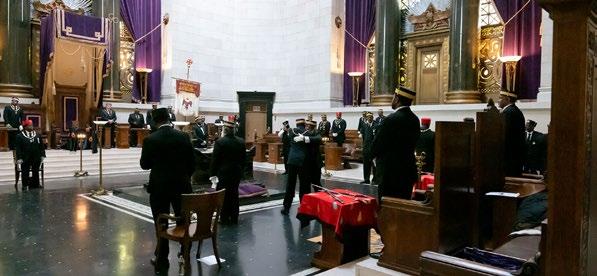
The second bus was scheduled to leave the host hotel at 9:00 a.m. with our visitors and other dignitaries, so I began calling for committee reports. All the reports were presented and voted upon in the affirmative and the only business remaining was the credentials report and candidates for the 33⁰ which would be done Saturday morning. I called the Session to
recess to return to labor at 9:45 a.m.
It was then time to share the moment with our visitors. I took the liberty as Deputy to have one special SGIG arrive with the second bus so that when the visitors arrived, I would receive him first. The overseer for the Works SGIG Marcus James, with an authoritative voice exclaimed from the door, “Illustrious Deputy, we have Past Deputy for the Orient of D.C. SGIG Paul Barry, 33⁰ requesting to enter!” I replied, “ADMIT HIM!!!!!” Much to the surprise of many in the room, they had no idea that SGIG Barry had arrived on Thursday. I wanted him to be received alone and not in the procession with me. As he stood at the gargantuan altar, I saluted him in the Temple Room occupied by the membership he had led and told him it was my extreme honor and privilege to receive him. I asked him to excuse me for vacating the East to escort him to his rightful place in the East. Withholding the emotions swelling up inside me, I approached him west of the altar and dismissed a handshake, and hugged him.
When most people made up their own stories about the relationship between SGIG Barry and me after my appointment, this was the moment to put all the conjecture and lies aside. No one knows that he has supported me since Day-1, and I will leave it at that.
I then began receiving my
guests:
• SGIG Stu Lee, 33⁰ USC, 33⁰ NJ representing the Orient of the Far East on behalf of Deputy Charles Bush, 33⁰
• SGIG Reginald Steward, 33⁰, USC, 33⁰ NJ
• SGIG Robert Taylor, 33⁰ (Orient of Maryland)
• SGIG Danny West, 33⁰ (Orient of Maryland)
• Illustrious Deputy for the Orient of Florida SGIG Chris Terrell, SGIG Patrick Worlds, 33⁰, GIG Rulx Beauchamp, 33⁰, and GIG Carlos Williams
• Illustrious Deputy for the Orient of the Republic of Liberia, SGIG Eden Charles Reeves, II, 33⁰
• Illustrious Deputy for the Orient of North Carolina, SGIG James Upchurch, 33⁰, SGIG Franklin Brown, 33⁰, SGIG Avie Lester, 33⁰, SGIG Herb Caviness, 33⁰, GIG Joseph Burwell, 33⁰, GIG Linwood Lane, 33⁰, GIG Mark Shivers, 33⁰, GIG Victor Neal, 33⁰, GIG Daniel Lewis, 33⁰
• SGIG Emmanuel Stanley, 33⁰, (Orient of Maryland)
• SGIG Len Proden, DCSR, Supreme Council, 33⁰, SJ
• Grand Secretary General H∴E SGIG Dr., L Ken Collins, 33⁰
• Grand Minister of State/Deputy for the Far East SGIG X.L. Butler, 33⁰ (representing SGC Hawkins)
After all, the guests were seated, I brought for the Grand Minister of State for his remarks to the fraters
in attendance. He reassured everyone that our USC was in a great place and that the SGC was happy with the great work everyone is doing.
Following his remarks, I explained to all the Southern Jurisdiction fraters in attendance that I was going to allow each of them to come to the east one by one to sound the gavel to raise the membership and seat them in the Temple room. As they did so, they were given a small replica gavel and a card stating that the replica gavel certified they had sounded the gavel in the Temple Room. At 11:00 am, I put the COD at recess until the next day, at which time we went downstairs to the grand staircase to take a group photo.
After the pictures, Elizabeth arranged for tours of the House of the Temple in which most attendees participated. I had arranged for lunch to be delivered at the HOTT so that all could dine together at High Noon. It was during this time that Elizabeth informed me that Grand Commander Cole had just arrived. When he entered from the library, I brought the entire room to attention and introduced him as the Grand Commander of the Supreme Council, a very special friend of our SGC Hawkins and USC-SJ, and our gracious host.
True to form, Grand Command-
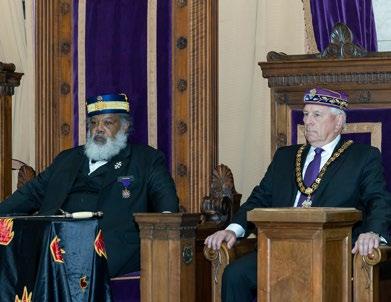
er Cole gave words of welcome but surprised everyone when he said he was offering a private tour of his office.
“WHAT!” I saw the same look on Daniel and Elizabeth’s faces. This was a special moment for even the Grand Commander.

I sat in the lobby absorbing the entire morning, but as I looked over the photos taken in the office by SP’s Victor Sherrod and Tony Mobley, I realized that just about everyone had taken his offer.
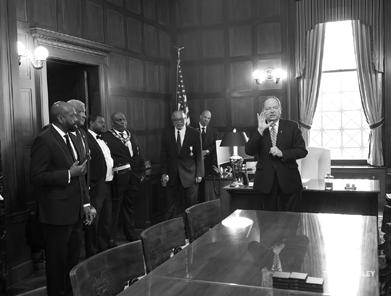
We went downstairs for lunch
with Grand Commander Cole and SGIG Proden and enjoyed delicious beef ribs, chicken wings, string beans, and baked beans and great conversation. Grand Commander asked if he could address the members, at which time he told a special story of his youth and how, as Grand Master, he was able to accomplish recognition with the MWPHGLVA by vote. He told everyone in the room that this day was as important for them as it was for us.
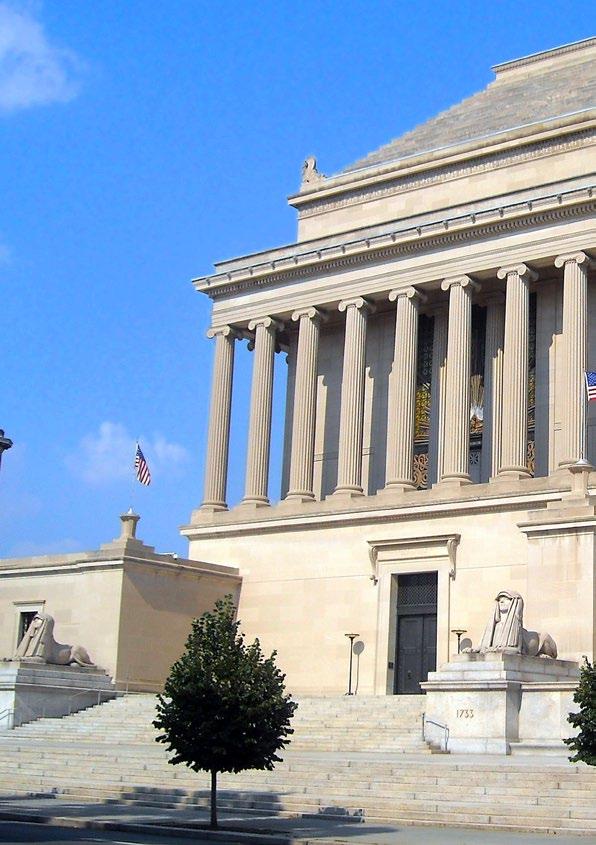
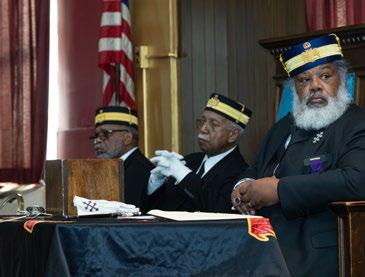
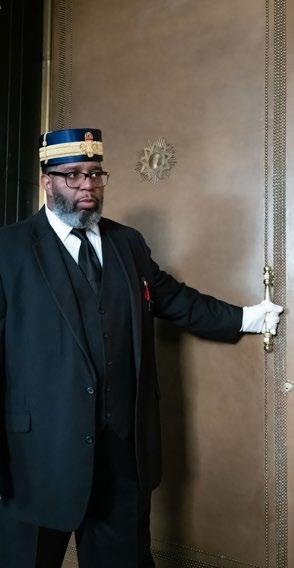
For 26 years, I have been a member of the Louis W. Roy Sr. Council of Deliberation and attended several of its annual sessions. This 2023 annual session made me pause to reflect upon where we came from and, quite frankly, the bright and magnificent future ahead. The atmosphere amongst the fraters was electrifying. You could cut the excitement with a knife. It had been several years since I had seen this much excitement or inspiration within our Orient. The motivation of our fraters was nothing less than stellar. Each frater wanted to participate, do their part, and ensure the success of an outstanding 2023 Council of Deliberation. You could even feel and hear the excitement in our honored guests who attended from North Carolina and everything in between to the Republic of Liberia.
The Orient rolled out the red carpet for the hospitality of our guests, and that has been the buzz I have heard in feedback from several who attended. “When you visit the Orient of the District of Columbia, you will be amazed at how they treat you.” From lodging to transportation to meals and activities, we intend to ensure each frater enjoys their stay and has pleasurable moments to remember the auspicious occasion marking their attendance. We had our
first-ever opportunity to welcome back to the Orient our Past Deputy, Sovereign Grand Inspector General Paul Barry, who was received with love and happiness by the Orient into the chambers of the House of the Temple. The efforts put into this council of deliberations annual session were a labor of love. The forms and ceremonies exhibited during the opening of the Council of Deliberation were astounding. Our Council of Deliberation 1st Lieutenant Marcus Crooks Sr. and the Council of Deliberation Officers performed flawlessly. This results from the ritualistic prowess that our fraters carry from their symbolic lodges in the Scottish Rite Bodies. The pride and professionalism of degree work exemplified in the District of Columbia is second to none in the Prince Hall Sodality. Sovereign Grand Inspector General Eric Konohia has made it his mission to rebuild the Orient of the District of Columbia and change the trajectory of its pathway to success. This formula was simple; everyone wants to be a part of something great, which can only be accomplished through total and complete inclusion. Everyone from Sublime Princes to Sovereign Grand Inspector Generals takes an active role in the movement of the Orient. And you can see it in the work produced by all.
We are the one and only Louis W. Roy Sr., Council of Deliberations located in Washington DC corresponding to the location near the B∴B and under the C∴C of that Zenith, which answers unto 38° 53’ 38.17” N. Latitude; also known as the BIRTHPLACE of the United Supreme Council, 33° of the Ancient & Accepted Scottish Rite of Freemasonry, Prince Hall Affiliation, Southern Jurisdiction of the United States of America.
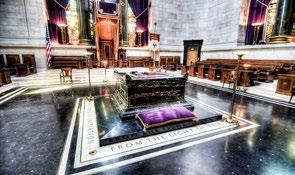
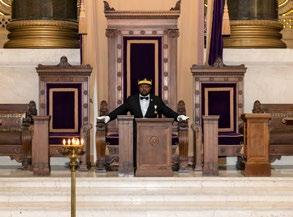
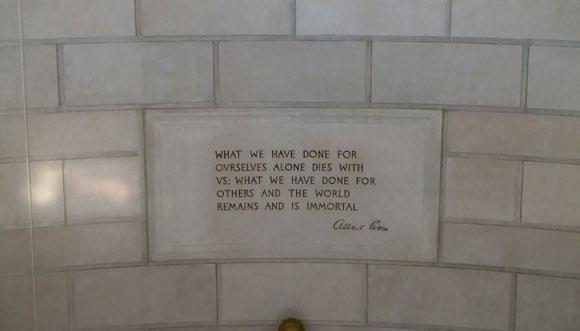
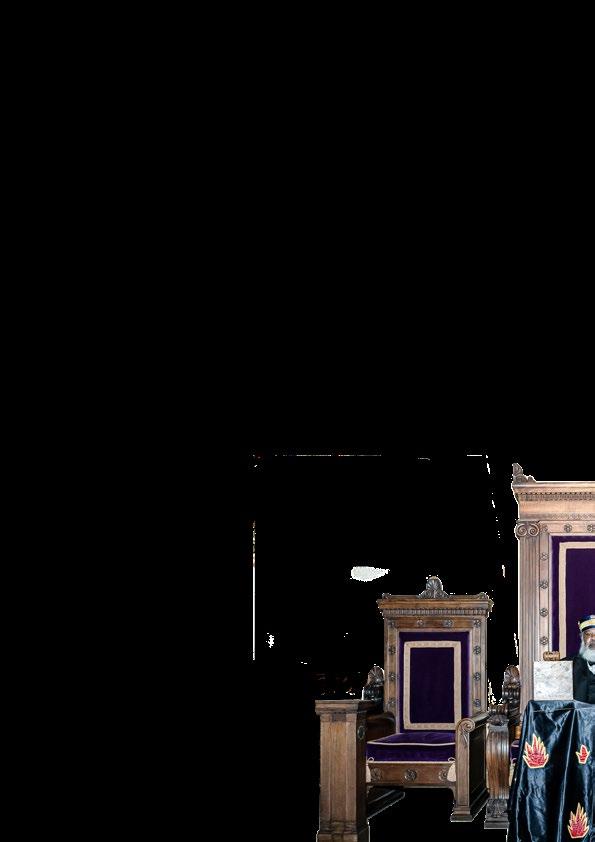
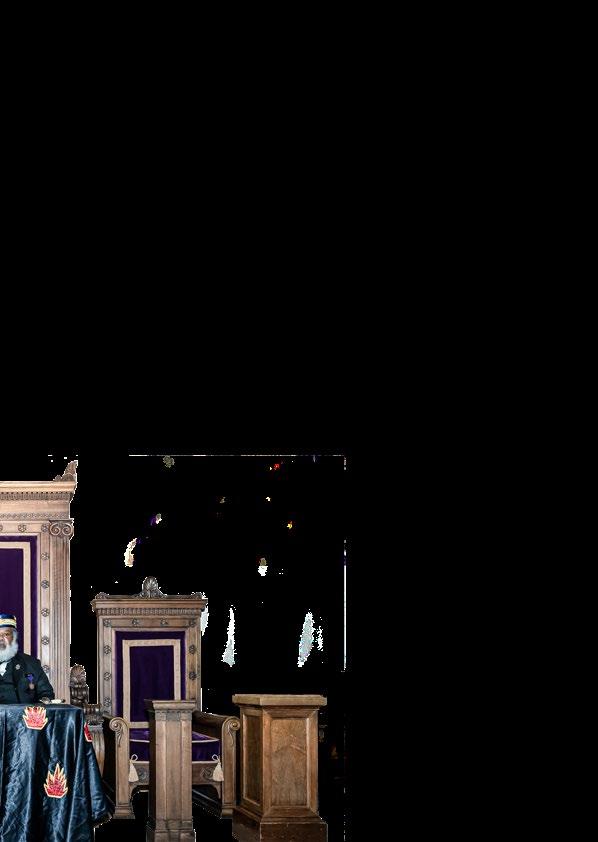


On March 18, 2023, the Deputy for the Orient of the District of Columbia and the SGLLR along with 58 fraters and 15 Loyal ladies traveled in mass in 2 chartered buses to visit the Virginia Council of Deliberation.
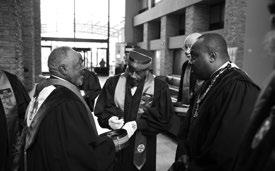

Members of the Orient boarded the buses before sunrise and arrived at the Holiday Inn and Conference Center, 5655 Greenwich Rd, Va. Beach, VA before 10:00 am. As our members disembarked both buses Deputy Konohia looked inside the meeting space and told the Master of Ceremonies for the VACOD that they needed more chairs in the chamber to accommodate the District of Columbia.
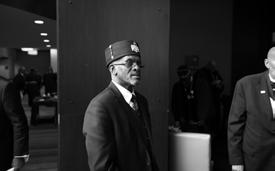
Once we were received the entire chambers was full with no empty seats. Illustrious Deputy Shelton Riddick commented that the full room, “Looked Good!” When he broke for lunch we took a group photo and boarded the buses to head back to D.C.
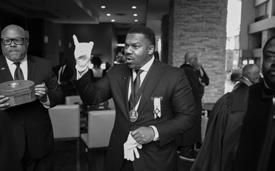
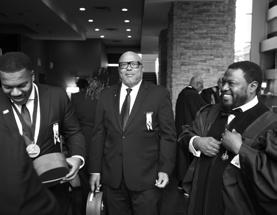
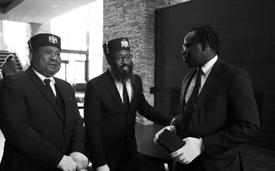
Deputy Konohia commented that we traveled in large numbers for no other reason but to show the Orient of Virginia that they have the full support of their neighbor to the north.

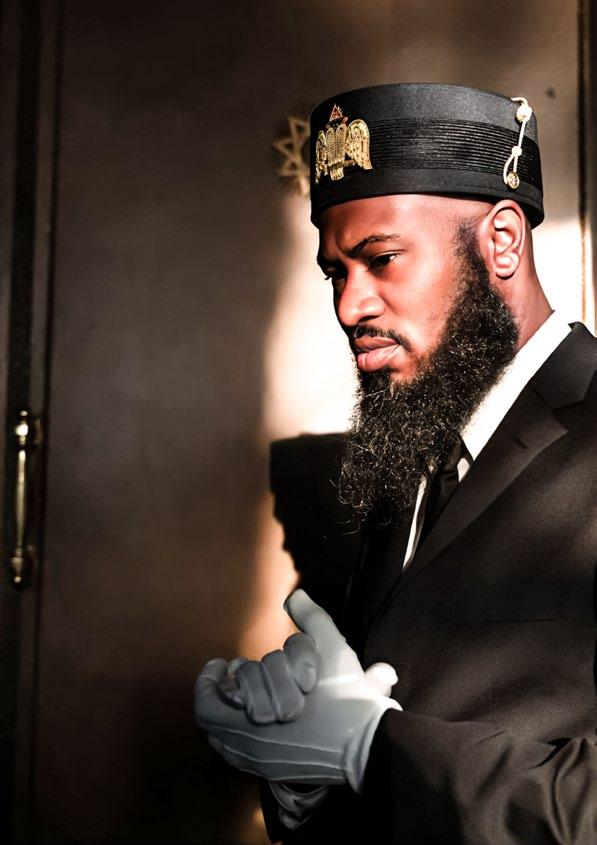
BENEVOLENCE
[ buh-nev-uh-luhns ]
See synonyms for: benevolence / benevolences on Thesaurus.com
Noun
1. desire to do good to others; goodwill; charitableness:to be filled with benevolence toward one’s fellow creatures.
2. an act of kindness; a charitable gift: Shebequeathedmanybenevolences from her vast fortune.

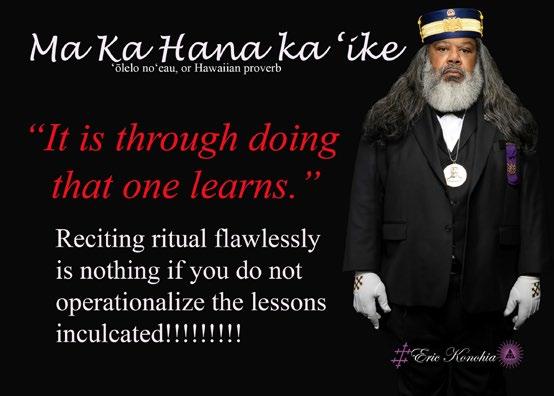
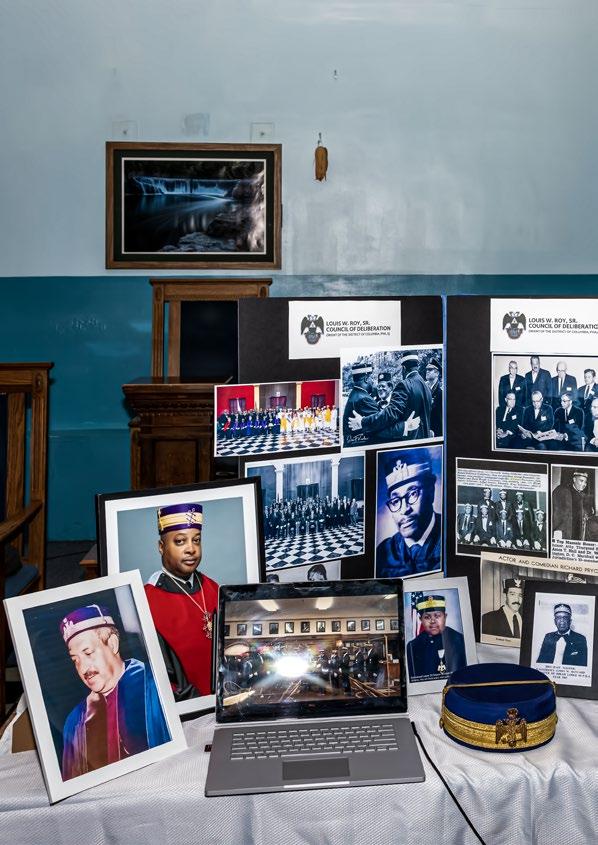
On Saturday, February 18, 2023, from 12p – 3p, The Most Worshipful Prince Hall Grand Lodge of the District of Columbia, held its annual Black History Month program, where all subordinate, adopted, appended, allied, and concordant organizations were invited to observe the dynamic organizational exhibits our jurisdiction presented for informational purposes. Our Black History Month exhibits were displayed in the North & South Halls on the 5th Floor of the Masonic Temple, which was designed by African American architect Albert I. Cassell and built between 1922 and 1930.
During slavery, segregation, and throughout history, there have always been many notable African American Freemasons and Eastern Stars who have made their mark on our country and our world. Our exhibits revealed those brothers and sisters who served and currently serve as role models for Black identity and empowerment. The Masonic Temple has always been an important social and cultural center for more than 70 years and was listed on the DC Inventory of Historic Sites in 1982 and on the National Register of Historic Places in 1983.
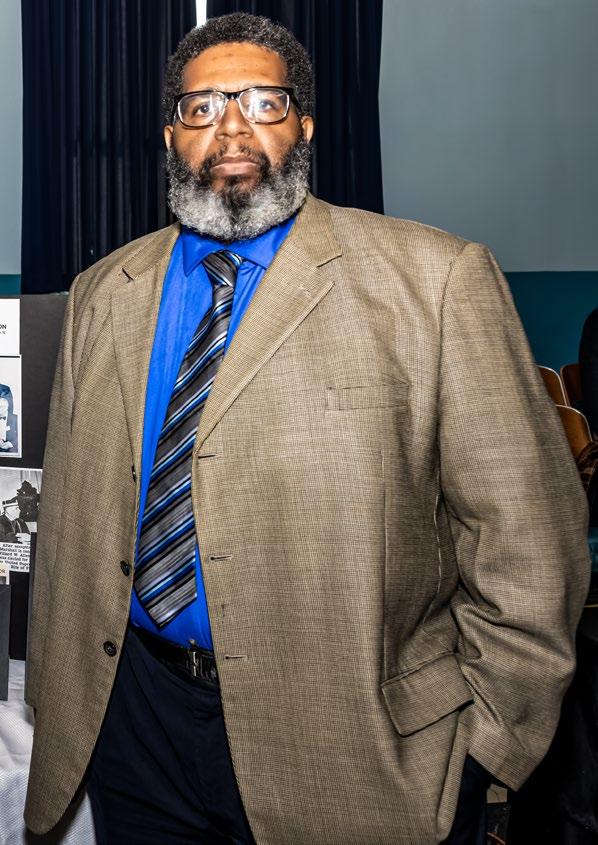
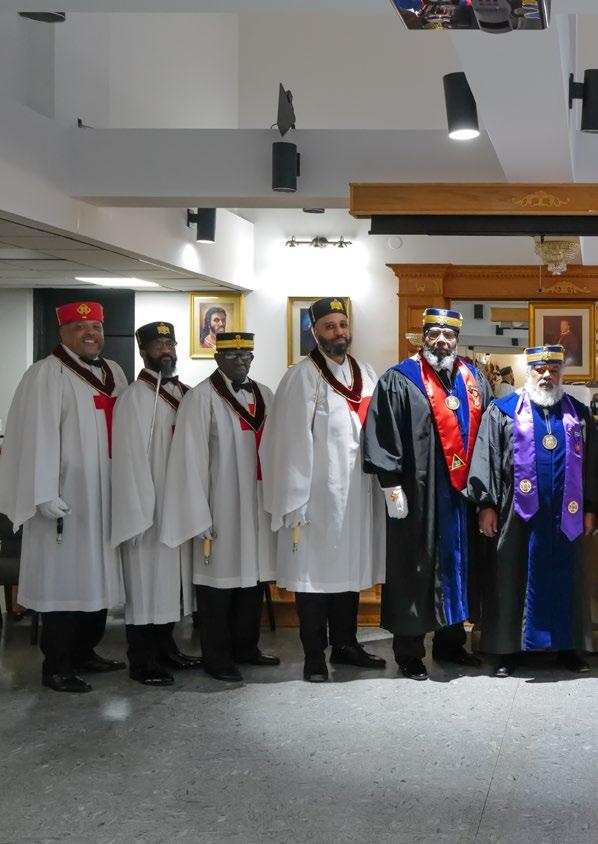
On April 9, 2023, Buddha Chapter No. 1 Knights Rose Croix under the leadership of Most Wise and Perfect Master Dgessey Major, 32⁰ performed the Easter Sunrise Service with ritualistic precision. Here are a few photographs from the Church. Thank you Elder Ronald Arberta and the Officers and members of UNITED HOUSE OF PRAYER FOR ALL PEOPLE 601 M Street, N.W., Washington, D.C. for your consistent support of the Louis W. Roy, Sr., Council of Deliberation.
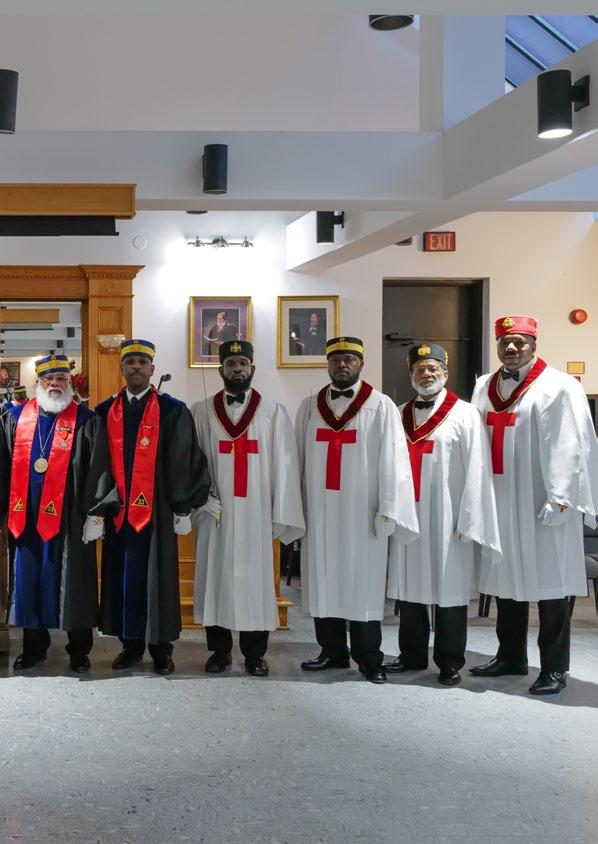
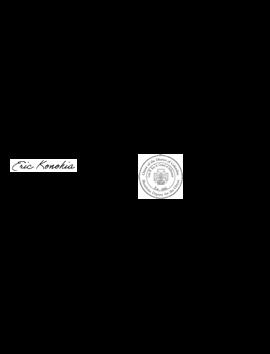
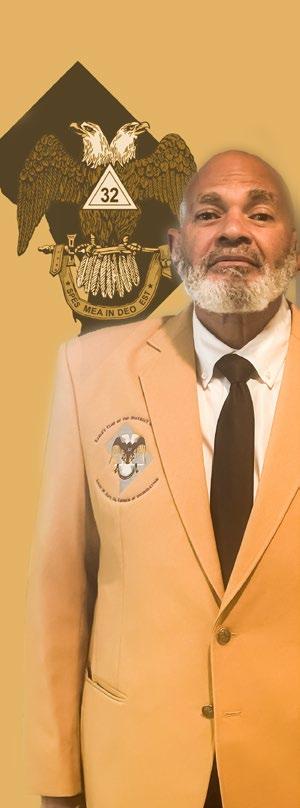
Phillip Harrigan, 32°
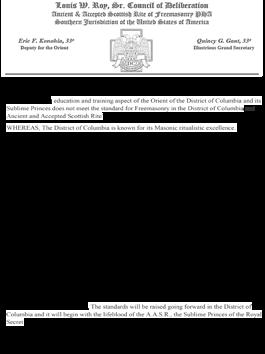
Bam Bam Bam, was the sound at the inner door of the South Hall at 1000 U. Street, NW Washington DC. Someone answers, asks a few questions, goes back, reports, then you’re allowed in, but you’re blindfolded. From that moment, your goal is to seek and find a way out of the darkness that you’re currently in. On three separate occasions, you find yourself in darkness and you are asked a simple question each time before that blindfold is lifted: “In your present situation, what do you most desire?” One hundred percent of the time, the answer would be “Light, More Light, or Further Light in Masonry.” But is that the case? Are we seeking the Light that we promised to seek?
Since being brought to Light in Masonry in February of 2014, I’ve often wondered if brethren, who have answered that question, were living up to that promise. Over the last nine years, I’ve seen many kneel at the Alter, before the Three Great Lights and the Great Architect of the Universe, answer that question, and never commit to seeking the Light they said they most desired.
From the time that we were Initiated into the mysteries of Freemasonry, we committed ourselves to obtaining knowledge and educate ourselves. The concept of seeking Light is one of the most funda-

mental aspects of the Fraternity. It’s closely related to the concept of personal growth and self-improvement, eventually becoming a better man. Seeking Light in Masonry is also tied to the belief in a Supreme Being, which every regular Freemason must believe in. This Light also aims to deepen the understanding of our relationship with the Divine, and to develop a greater sense of purpose and meaning in our lives.
The pursuit of knowledge and wisdom is a lifelong journey, and Freemasonry offers its members a wide range of opportunities to continue seeking light. Masonic lodges often provide educational programs and resources, such as lectures, seminars, and books, to help members deepen their understanding of the principles of Freemasonry. But are we taking advantage of those opportunities?
In addition, Masonic rituals and ceremonies are designed to help members gain a deeper understanding of the symbolism and allegory of Freemasonry. These rituals are rich in symbolism and meaning, and they are intended to inspire and enlighten Masons at every stage of their Masonic journey.
Ultimately, the pursuit of light in Freemasonry is a deeply personal journey. Each Mason must chart their path and seek out their sources of knowledge, wisdom, and truth.
Those who are surrounded with knowledge and opportunity for self-improvement and make nothing of these opportunities are lazy workmen who will be spiritually, if not physically, cast out of the temple of the King.
(1 The Lost Keys Of Freemasonry p. 31)
The prophet Malachi is a key figure in the history of the Israelite people. He is known for his prophetic messages, which he delivered to the people of Israel during the 5th century BC. Malachi’s messages focused on issues such as social justice, religious corruption, and the coming of the Messiah.

Malachi is believed to have lived and worked during the time of the Jewish restoration from the Babylonian captivity. This was a time of great upheaval for the Jewish people, as they were returning to their homeland after many years of exile. The restoration period was marked by significant challenges, including the rebuilding of the Temple in Jerusalem and the re-establishment of the Jewish community.
Malachi’s prophetic messages were delivered in the form of a book, which is included in both the Hebrew Bible and the Christian Old Testament. The book of
Malachi is composed of a series of dialogues between the prophet and the people of Israel. These dialogues address issues such as the corruption of the priesthood, the importance of social justice, and the coming of the Messiah.
One of the key themes of Malachi’s messages is the corruption of the priesthood. Malachi accuses the priests of neglecting their duties and not following the laws of God. He also condemns them for accepting offerings and sacrifices that are not pure, and for showing partiality to certain members of the community. Malachi warns the priests that if they do not repent, God will punish them.
Malachi’s messages also emphasize the importance of social justice. He speaks out against those who oppress the poor and the vulnerable, and he calls on the people to treat each other with fairness and compassion. He also condemns those who engage in dishonest business practices and
cheat others out of what is rightfully theirs.
One of the most significant prophecies in the book of Malachi is his prediction of the coming of the Messiah. Malachi refers to the Messiah as the “messenger of the covenant,” and he prophesies that the Messiah will come to purify the priesthood and restore true worship to the people. Malachi’s prophecy provides hope for the future and reminds the people of Israel of God’s ultimate plan for their redemption.
In conclusion, the prophet Malachi played a vital role in the history of the Israelite people. His prophetic messages addressed critical issues facing the community during the restoration period, and his prophecies of the coming of the Messiah provided hope for the future. Today, the book of Malachi remains a powerful reminder of the importance of following God’s laws and treating others with justice and compassion.
To learn to subdue my passions and improve myself in Masonry.
Having been divested of metallic substances early in this process, one is now challenged to map out his path in masonry while subduing his passions. Where do you see yourself in the organizational chart? Have you established a mental or written timeline of your new goals?
The Scottish Rite has long been associated with a set of values and principles that are intended to guide the actions of its members. One of the most important among these values is the idea of subduing one’s passions. This concept is closely linked to the idea of self-control and discipline, and it is essential for those who seek to embody the ideals of the Scottish Rite.
At its core, the idea of subduing one’s passions is about recognizing that our emotions and desires can lead us astray if we allow them to. When we are driven solely by our passions, we can become reckless, impulsive, and even dangerous. Therefore, by learning to control our passions, we can become more rational, thoughtful, and deliberate in our actions.
However, subduing one’s passions is not an easy task. It requires a great deal of self-awareness, discipline, and commitment. To truly control our passions, we must first understand them. We must recognize how our emotions and desires influence our thoughts and actions and learn to recognize when they are leading us astray.
Once we have gained this self-awareness, we can begin the work of subduing our passions.
This involves developing the discipline to resist our impulses, even when they are strong. We must learn to delay gratification, control our anger, and remain calm in the face of adversity.
Of course, this is easier said than done. It takes time and practice to develop the self-control necessary to subdue our passions. But with persistence and dedication, it is possible. Can you aspire to a higher role while subduing your passions or do you allow others to guide your path?
In the context of the Scottish Rite, the concept of subduing one’s passions takes on a particular significance. As members of this organization, we are expected to embody certain values and ideals, including those of self-control, discipline, and rationality. By learning to control our passions, we can become better representatives of these ideals, and better members of the Scottish Rite.
In conclusion, the concept of subduing one’s passions is a critical aspect of the Scottish Rite’s philosophy. It requires a great deal of self-awareness, discipline, and commitment, but it is essential for those who seek to embody the organization’s values and principles while allowing the utilization of your inherent gifts for the betterment of masonry. Through the process of subduing our passions, we can become more rational, thoughtful, and deliberate in our actions, and better representatives of the Scottish Rite’s ideals while moving forward within the organizational structure.
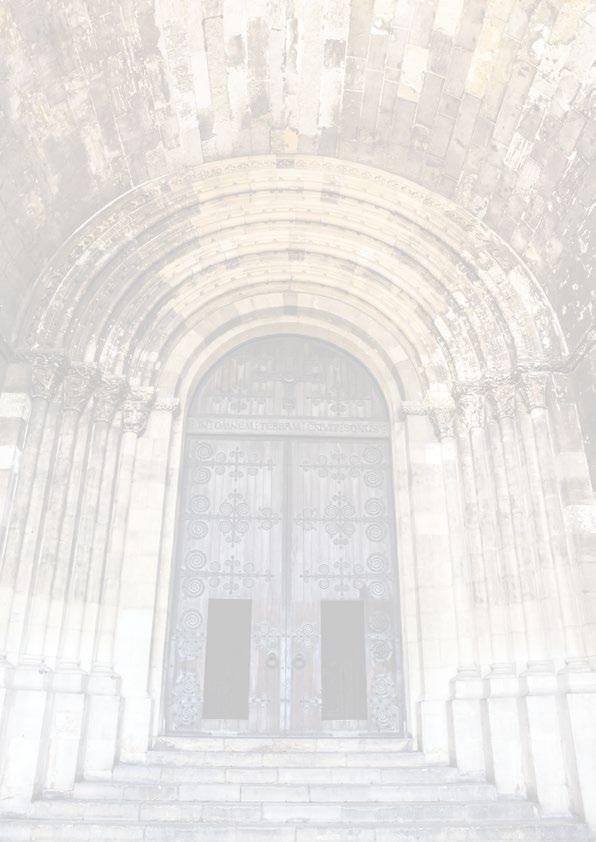

These are the words from Knight Commander Mark Fair, 32°, Chief of Staff for the Deputy of the Orient to the twenty newest members of the Louis W. Roy, Sr. Council of Deliberation, Orient of the District of Columbia, Prince Hall Affiliation, Southern Jurisdiction, as they were about to receive their black caps.

The Capping Ceremony of the new class was held on February 27th, 2023 during the first Rendezvous of Jonathan Davis Consistory No. 1 for the new year. The 2023 class was named in honor of Sovereign Grand Inspector General Bert A.G. Overby, 33° who served as the Most Illustrious Commander-in-Chief of the Louis W. Roy, Sr.
Council of Deliberation and Deputy for the Orient of DC from 1992 – 2006. During his tenure as Deputy, he expanded the Orient by chartering our three Consistories: James W. Banyard Consistory No. 11, Henry A. Dove Consistory No. 15, and Johnnie L. Doctor Consistory No.18.
The ceremony opened with prayer by Illustrious Prior, Knight Commander Dr. Paul Cotton, 32°, followed by the history and significance of the Scottish Rite, with inspirational words given including the words aforementioned at the beginning of this article. As names were called by Sublime Prince Fred N. Smith, Jr., 32°, KSA for Jonathan Davis Consistory, Knight
“In the Scottish Rite, your new cap indicates the consecration of one’s spiritual and physical attributes towards the betterment of humanity…thus your cap should serve as a constant reminder that the physical is always subject to the spiritual and that, like Knights, we valiantly endeavor to maintain virtue and honor by applying moral sense and reason.”
Here is a short video of some of the highlights of that night. There is a difference when you make the Initiatic Experience special to the person receiving the Degree.
In the Scottish Rite, the caps indicate the consecration of one’s physical and spiritual (material and intellectual) attributes to the betterment of humanity.
On the one hand, the caps are an inheritance from our chivalric tradition, as similar ones were associated with European orders of Knighthood, where they evolved from the Army Bonnet, worn under the helmet.
On the other hand, they were also worn as a type of prayer cap, a tradition which also survives in some religions.
Thus, the caps are a constant reminder that the physical must be subject to the spiritual and that, like knights, we must valiantly endeavor to maintain honor and virtue by applying the Moral Sense and Reason.
We wear them to show our respect and devotion to God and to identify ourselves as Masons of the Scottish Rite.
As the white lambskin is the Badge of a Mason, so is the regulation cap the Badge of a Scottish Rite Mason.
The cap denotes a Master of the Royal Secret, the title of a 32º Mason of the Scottish Rite.
The Supreme Council has set forth a rule for the correct wearing of the cap.
When wearing a cap it shall be considered to be a part of the apparel of the wearer.
At prayer, the cap is removed and held over the heart with the left hand.
Commander Kevin Moultrie, 32°; Illustrious Chancellor and President of the Eagles Club; presented the caps as they were bestowed by the Most Illustrious Commander-In-Chief and Deputy for the Orient of the District of Columbia, Sovereign Grand Inspector General Eric F. Konohia, 33°; and the patents presented by Illustrious Commander-In-Chief for Jonathan Davis Consistory No. 1, Grand inspector General Vincent H. Fadis, 33°.
Upon completion of the bestowal; the Charge, the United Supreme Council Mission, and Prince Hall Credo was relayed by Grand Inspector General Fadis, who charged the newly advanced
Fraters to “embrace and hold the rights, privileges, and responsibilities of membership.”
Remarks were provided, beginning with the Class President, Sublime Prince Matthew Williams, 32°, who gave thanks to all Fraters present for accepting their class into the Scottish Rite. He also gave truly inspiring words stating that his class “…understands the importance. We understand the privilege, and last but not least, we will continue to apply PRESSURE within and without this Orient.”
Following this response from the Class President, further remarks were provided by Knight Commander Fair; a welcome by Grand Inspector General Fadis and
Illustrious Overseer of the Works, Sovereign Grand Inspector General Marcus D. James, Sr., 33°, who reminded the new class that they are the future of the Council and will continue to add to its greatness.
The illustrious Overseer took a moment to acknowledge Fraters who were also in attendance. These are the Commanders-In-Chief of the Consistories; Grand Inspector General Vincent H. Fadis, 33° (Jonathan Davis Consistory No. 1), Grand Inspector General David A. Washington, 33° (James W. Banyard No. 11), Grand Inspector General Guy Borden, 33° (Henry A. Dove No. 15) and Grand Inspector General Seterial Thurman, 33° (Johnnie L. Doctor No. 18).
Following this acknowledgment, the Illustrious Overseer introduced for his comments Sovereign Grand Inspector General Eric F. Konohia, 33°. Deputy Konohia held his remarks so the class could hear from the dignitaries that traveled to be present for the ceremony.
These include Sovereign Grand Inspectors General Stu Lee, 33° and Reginald Stewart, 33° of the United Supreme Council, Ancient and Accepted Scottish Rite of Freemasonry, Prince Hall Affiliation, Northern Jurisdiction, U.S.A., Inc.; Most Worshipful Past Grand Masters for the Most Worshipful Prince Hall Grand Lodge of the District of Columbia, Grand Inspector General John Raymond Murray, 33°, Grand Inspector General Warren R. Whitley, 33°, and Sovereign Grand Inspector General Quincy G. Gant, 33°; Right Worshipful Deputy Grand Master for the Most Worshipful Prince Hall Grand Lodge of the District of Columbia, Sovereign Grand Inspector General Glenn N. Ruffin, 33°.
The final dignitary remarks came from one of the Elected Officers of the United Supreme Council, Ancient and Accepted Scottish Rite of Freemasonry, Prince Hall Affiliation, Southern Jurisdiction, USA, Inc., Grand Secretary-General of the Holy Empire, Sovereign Grand Inspector General L. Ken Collins, II, 33°, who relayed to the new Fraters that they are the lifeblood
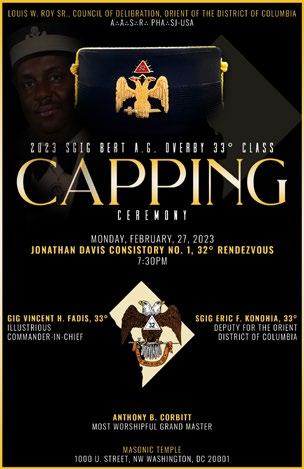
of Freemasonry within their consistories, Scottish Rite takes their work very seriously, and sharing one his lessons from his Father that “it doesn’t take all day to do nothing,” emphasizing that any one of them can step into a role where the work is needed and fill it.
The Most Illustrious Commander-In-Chief of the Louis W. Roy, Sr. Council of Deliberation and
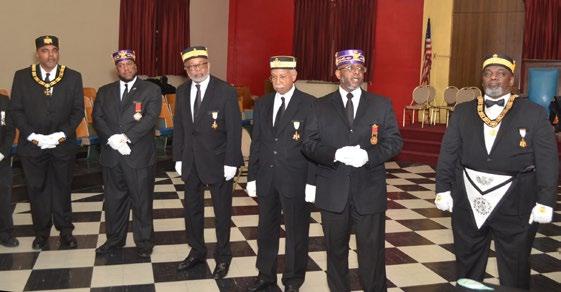
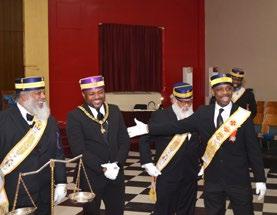
Illustrious Deputy for the Orient of the District of Columbia, Sovereign Grand Inspector General Eric F. Konohia, 33° provided final remarks to the class, informing them that this couldn’t have been a better time to become a Scottish Rite Mason in this Orient, noting the recent achievements of the Orient, including but not limited to our recent Charter Day activities. He also stated that there is still more
work to be done, and he is looking for all Scottish Rite of this Orient to answer the call.
The ceremony concluded as it began, with a prayer from Knight Commander Dr. Paul Cotton, 32°. The capping ceremony was an auspicious event where the torch was passed to 20 new Sublime Princes, with the mission given to all within this Orient…to be Steadfast, Set Solid, and Immovable.
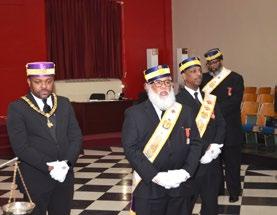
The light of Masonic knowledge ever burns brightly. No one said it would be easy and as the young generation would say “True That.” I am learning the meaning of stress. For example, the pressure and strains of consistory life. However, my journey has given me ways to find my best work style. The key is persistence and tenacity. I am using knowledge gained from previsions administrations. For example, I am beginning to delegate to a greater extent. The bottom-line question: Is stress always negative? To that, I would “No.” Some stress is important for Masonic development. However, I am learning the three R’s: to rest, relax and recuperate. Haste has no blessing, from a Swahili proverb. Are you ready for the question: Are you a lover of Wisdom?
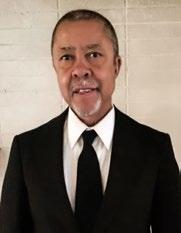
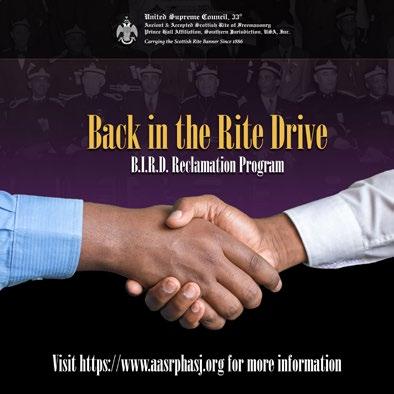
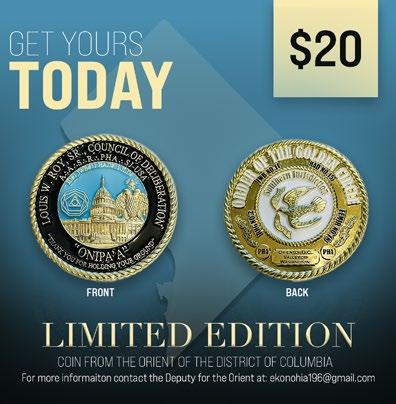
Stiff and cold in that wooden house, my fallen colleague was laid to rest at the tender age of 37, just a few months before his birthday. Rumors about the details of his passing swirled around and I listened for some time, trying to triangulate and get the truth of the matter. I was taking what I knew of him and coloring the rumors with the intimate details from our decades-long friendship. I had to stop after a while. It was maddening going over the possibilities and trying to connect what I knew about him to what happened. I ultimately rested on a simple fact that provided solace during that dark hour: my friend in life would be my friend in death. “…O grave, where is thy victory?”
For those initiated, passed, raised, and ADVANCED, we are charged on many occasions during the journey to reflect, ponder, and think. It has recently been decided by the Illustrious Dr. Corey D. Hawkins, Sovereign Grand Command of the Ancient and Accepted Scottish Rite Prince Hall Affiliation for the Southern Jurisdiction, that at the opening of every meeting that John 15:13 should be read:
Greaterlovehathnomanthan this,thatamanlaydownhislife forhisfriends.
I am sure, there are Masons more astute than I that have similarly wondered, the simplest yet
often vexingly perplexing, “Why?” Universality says I cannot say what one should believe. I will share one of my beliefs for consideration, in hopes that the reader is inspired to reflect, ponder, and think.
I believe all things work in Divine Order. I would argue the evidence is all around us. One needs only look up in the night sky; reach down and touch blades of grass; or listen out to the sounds of the rolling sea. It is a cycle of Movement, Creation, Life - “Death”. Death, a messenger that will eventually knock on each of our doors, take us by the hand, and usher us to that undiscovered country of good men made perfect. This stark contrast to our everyday lives is a change we all will experience, whether we’re prepared or not, welcome it or not, and ask for it or not. The cycle, Divine Order, says our days are numbered, so we are to live as though this great change is coming. Every day on this plane is a reminder of one of the great lessons in our lectures reminding us of the soul that never dies. It merely transitions; it changes.
In the book of John chapter 13, Christ is talking to his disciples. When a man “lays down his life”, and experiences death he does not cease to exist. He experiences a change, going from one state of being to another. I contemplate, reflect, ponder, and think about what changes must one
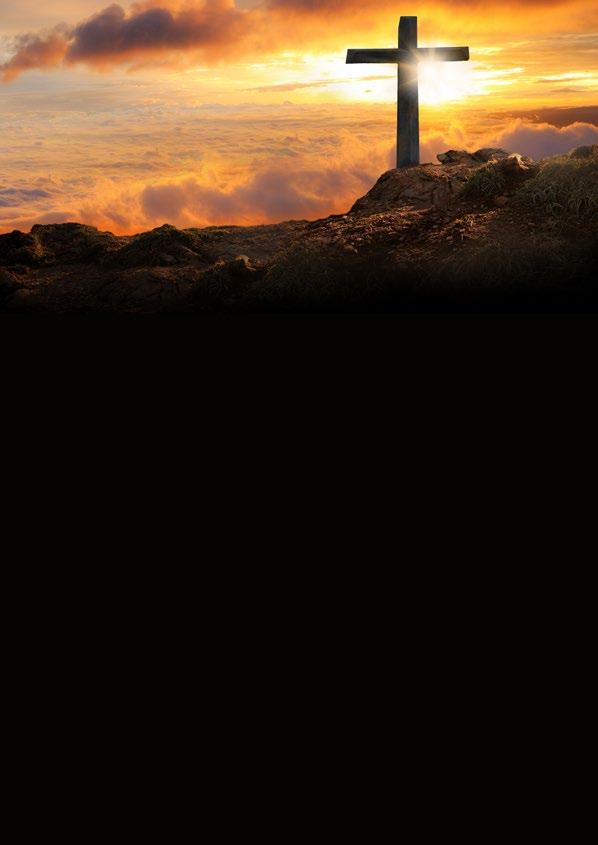
go through to be a better service to his friends, his brothers. I am not referring to death in the conventional sense. I am speaking of death allegorically. I am not referring to brothers in the fraternal sense. I am speaking of the brotherhood of man under the Fatherhood of God. What has to “die” in order for me to be greater testimony to the goodness of God? What change must I go through to be a better service here, to further instill faith in what is There?
Reflecting, my contemplative mind tells me Divine Order saw fit that my friend goes to the other side before me. That I might have a place prepared in Glory with a cheerful face to greet me on arrival. I ponder the possibility that my friend went forward that I might look back on this life, and be more diligent with the common gavel. Ultimately I think, I am thankful The Almighty saw fit to illuminate my undeserving life with the Light of a person who gave more than they took, laughed more than they cried, and praised more than they complained. Knowing my dear friend went through his change has better prepared for me my change when it comes, and has given me clarity on what needs to be laid down here in the terrestrial before I see the Celestial. Amen.
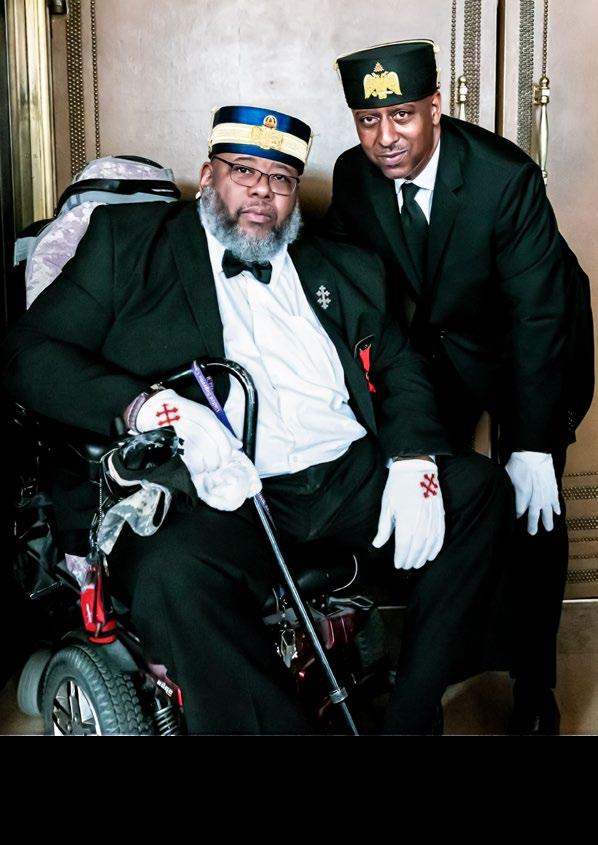
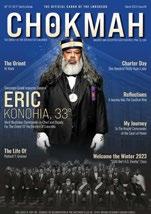
“It is not the critic who counts; not the man who points out how the strong man stumbles, or where the doer of deeds could have done them better. The credit belongs to the man who is actually in the arena, whose face is marred by dust and sweat and blood; who strives valiantly; who errs, who comes short again and again, because there is no effort without error and shortcoming; but who does actually strive to do the deeds; who knows great enthusiasms, the great devotions; who spends himself in a worthy cause; who at the best knows in the end the triumph of high achievement, and who at the worst, if he fails, at least fails while daring greatly, so that his place shall never be with those cold and timid souls who neither know victory nor defeat.”
Theodore RooseveltJONATHAN DAVIS CONSISTORY NO. 1
Rendezvous: 4th Monday of the month @ 7:30pm
February, May, October, December
Illustrious Commander-In-Chief
Vincent F. Fadis, 33°
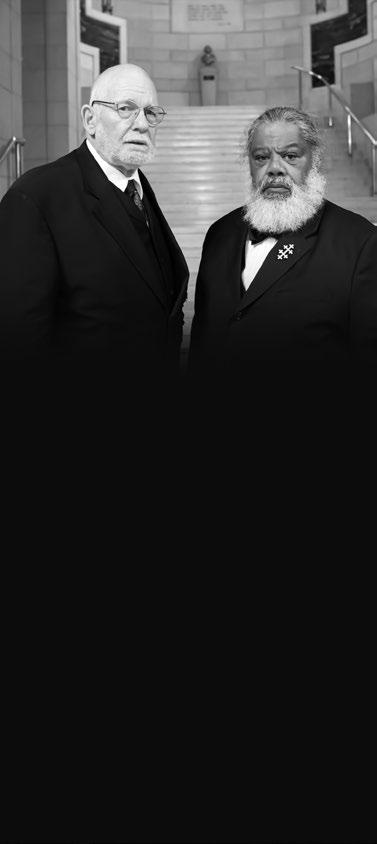
JAMES W. BANYARD CONSISTORY NO. 11
Rendezvous: 2nd Monday of the month @ 7:00pm
February, May, September, December
Illustrious Commander-In-Chief
HENRY A. DOVE CONSISTORY NO. 15
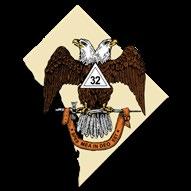
Rendezvous: 1st Tuesday of the month @ 7:00pm
March, June, September, December
Illustrious Commander-In-Chief
Guy Borden, 33°
JOHNNIE L. DOCTOR CONSISTORY NO. 18
Rendezvous: 4th Tuesday of the month @ 7:00pm
January, April, July, October
Illustrious Commander-In-Chief
Let everyone know! For as little as $10 per issue organizations outside of the Orient of the District of Columbia can list your upcoming events. Email chokmah@lwrsrcod.org for more information.
Albert Pike died on April 2, 1891, in at the Scottish Rite Temple of the Supreme Council in Washington DC, at the age of 81,and was buried at Oak Hill Cemetery, despite the fact that he had left instructions for his body to be cremated.In 1944, his remains were moved to the House of the Temple, headquarters of the Southern Jurisdiction of the Scottish Rite. The House of the Temple.
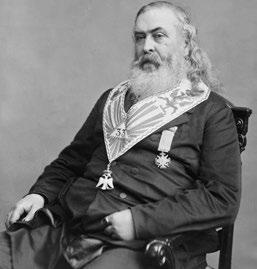
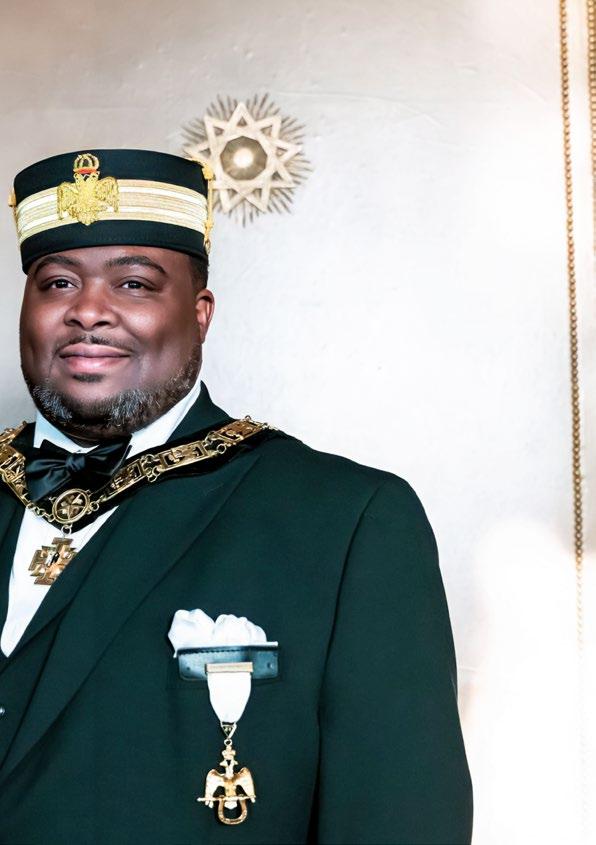
SQUARE WORSHIPFUL WARDEN
TOKEN SPECULATIVE RITUAL REFRESHMENT
PROFANE
OPERATIVE OBLIGATION
MYSTERY
LIBERTINE
LEGEND INITIATION
GEOMETRY
ESOTERIC EAVESDROPPER
DOTAGE DISPENSATION
DEGREE DEMIT
DEACON CONSECRATION
COMMUNICATION
CLANDESTINE CIRCUMAMBULATION
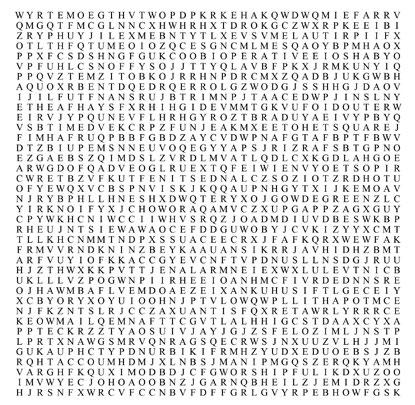
CHARITY
CEREMONY
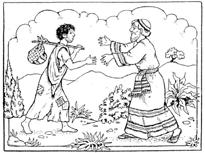
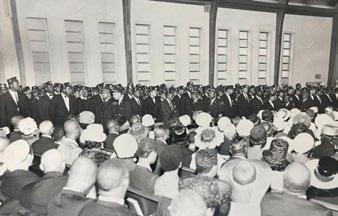
CARDINAL ASHLAR ALLEGORY
ALARM
ANCIENTANDACCEPTED
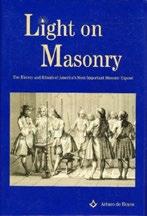 By De Yoyos, Arturo
By De Yoyos, Arturo
This book includes early versions of the rituals of the Blue Lodge, York Rite, Scottish Rite, and Order of the Holy Cross, as well as anti-Masonic committee reports, and letters from seceding Masons. Although it was originally intended as a hostile work, its contents help us understand and trace the evolution of Masonic ritual.
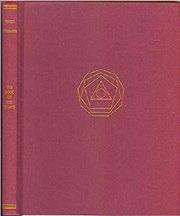
For serious students of Albert Pike’s 19th-century revisions of the rituals of the Ancient & Accepted Scottish Rite, this book provides a type of Masonic etymological dictionary of significant foreign words that appear in the ritual, especially words in Hebrew and Samaritan. Written in 1870 and 1871, and first published in 1878, two editions were published by Pike. The second edition included additional material, which is reproduced in this new volume. It is an amazing treasure, and a glimpse into the mind of this 19th-century Masonic genius.
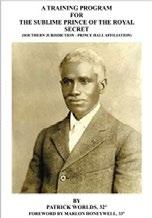 By Patrick Worlds, 32°
By Patrick Worlds, 32°
The Program provides a structural course of instruction for the candidate seeking advancement to the 32nd degree of Scottish Rite Freemasonry. Contained within this course of study are assessment tools for each of the lower houses as well as a short synopsis of each of the high degrees. The course length spans 26 weeks in which numerous sources of Scottish Rite material is referenced from freemasonry’s leading scholars! The Scottish Rite is commonly referred to as the College of Freemasonry and upon completion of this gentleman’s course, the candidate will be better suited to assume his title, Sublime Prince of the Royal Secret.
Suggested Reading: Chokmah welcomes book submissions for suggested readings. The only requirement is that the book has a connection with Freemasonry and the Ancient and Accepted Scottish Rite. To submit a book, send an email to chokmah@lwrsrcod.org. The suggested book must have an ISBN and be available for purchase by the general public (printed book, e-book, audiobook).

Sovereign Grand Commander Supreme Council 33°, Scottish Rite of Freemasonry, SJ, USA
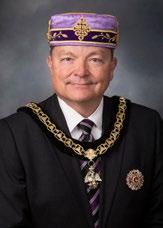
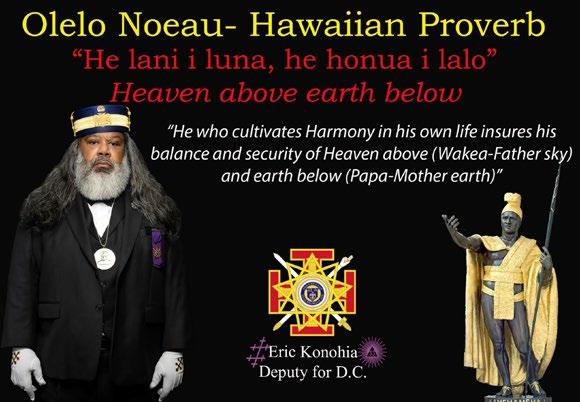
Illustrious Sir, This is a very impressive achievement. The publication is extremely well done. I read with interest your article “The Unattended of the Building.” I may well borrow, with attribution, that title one day! I was thrilled to see the exciting article about the Red Caps. Your Inaugural Class looked great. What a great start! It even had not one, but two pictures of Len Proden! Take care and please extend my congratulations to your publication’s staff.
Send your letters to the editor by:
Email: chokmah@lwrsrcod.org
Postal: 1000 NW U. Street Washington, DC 20001
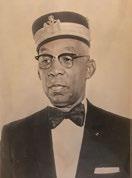
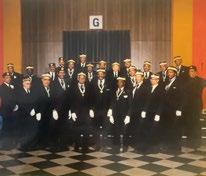
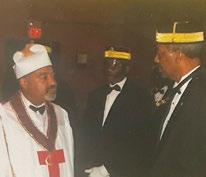
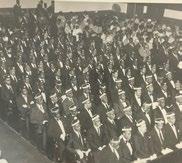
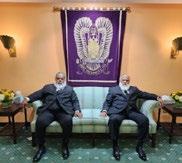
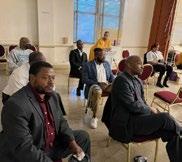
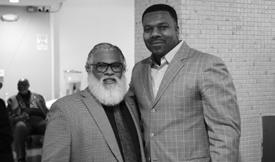
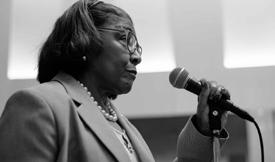

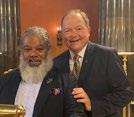
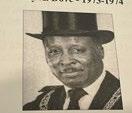
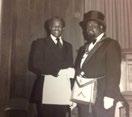
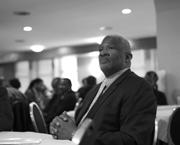

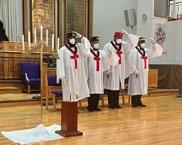
1. SGIG James M. Moore, 33° Illustrious Commander-InChief
2. Jonathan Davis Consistory #1
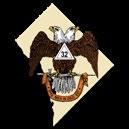
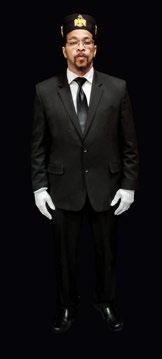
3. Maundy Thursday feast hosted by Buddha Chapter No.1 Knights of Rose Croix.
4. Anniversary and Divine Service circa 1970’s
5. Illustrious Deputy for the Orient SGIG Eric Konohia, 33° and RWDGM/SGIG Glenn Ruffin, 33° at the 2023 Installation of the officers of Mithras Lodge of Perfection, Evangelist Chapter of Rose Croix, Robert de Bruce Council of Kadosh and Albert Pike Consistory for the Valley of Wasington, Orient of DC, Supreme Council, “Mother Council”, Southern Jurisdiction, USA.
6. Fraters and Loyal Ladies at the Louis W. Roy Sr. Council of Deliberation and Matthew Ellis, Jr. State Grand Assembly Order of the Golden Circle Game Night.
7. RWDGM/SGIG Glenn Ruffin, 33°and KCCH Kevin Moultrie, 32° attending the MWPHGLDC Black History Program Luncheon.
8. PGWM / PSGLLR Margaret Anderson
9. Illustrious Deputy for the Orient SGIG Eric Konohia, 33° and State Grand Loyal Lady Ruler Shelly L. Walker, Ph.D.
10. Illustrious Deputy for the Orient SGIG Eric Konohia, 33° and SGC James. D Cole, 33° SC, SJ, USA
11. MWGM Henry A. Dove - 1973-1974
12. WM Burt A.G. Overby after the raising of Mayor Marion Barry. WM Overby later became SGIG Overby and Deputy for Washington, DC.
13. GIG Jeffrey Anderson, 33° attending the MWPHGLDC Black History Program Luncheon.
14. The Orient of the District of Columbia at the Florida Council of Deliberation Workshop, Orlando, Florida.
15. Buddha Chapter No. 1 Knights Rose Croix under the leadership of Most Wise and Perfect Master Dgessey Major, 32⁰ performing the Easter Sunrise Service.
We are always seeking well informed brothers to submit an editory, story idea, a article from the history and archives, a poem, or photos.
If you have those desires, please email SP Matthew Williams, 32° at chokmah@lwrsrcoddc.org.
HUMBLED AND HONORED TO BE APPOINTED AND SERVE AS THE EDITOR-IN-CHIEF
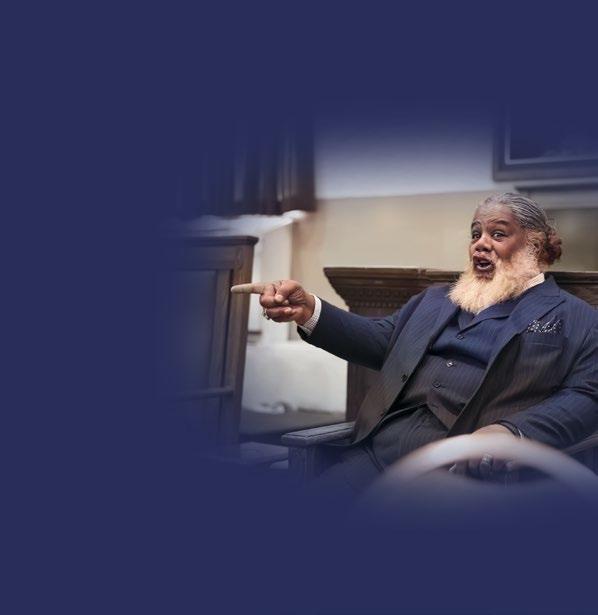

“SYMBOLICALLY MOST OF THE MASTER MASONS IN YOUR LODGE ARE STILL IN THE NORTHEAST CORNER. IT IS YOUR DUTY TO GO BACK THERE AND LEAD THEM TO THE LIGHT OF THE RITE.”